


Visiting the Tower of Pisa is fascinating, because Pisa doesn’t really have a lot going on otherwise. There is no chance it would be any kind of touristic destination if those guys hadn’t fucked up building that tower. Sort of an interesting example of failing upward.
I wanted to stay the night in a lousy place in town so I could tell people “I stayed in a Pisa shit hotel” but ultimately decided that degree of dedication to puns might be unhealthy.
I regretfully decided to settle for taking a photo whenever I saw a Pisa shit car go by, but I ended up taking a photo of my Pisa shit thumb instead.
The pathway between the train station and the tower is hectic and ill-defined, a mile and a half of walking in the street when the sidewalk suddenly gave up or somebody parked a cement truck on it. Seems like they might want to find a better way to facilitate the only reason anybody is coming to their town, maybe a shuttle bus that drives on two wheels or something, stay with the theme.
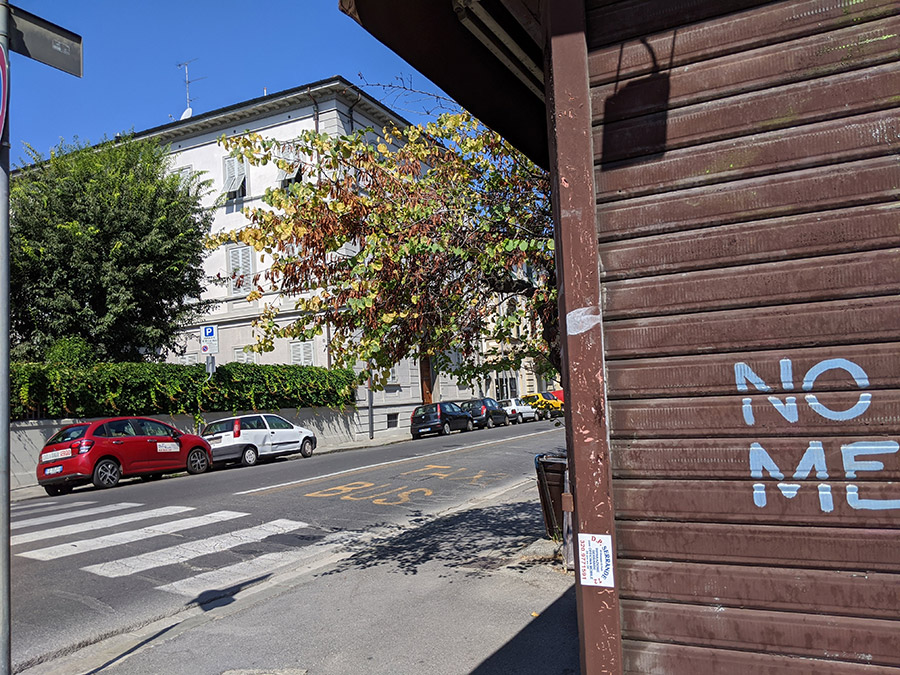
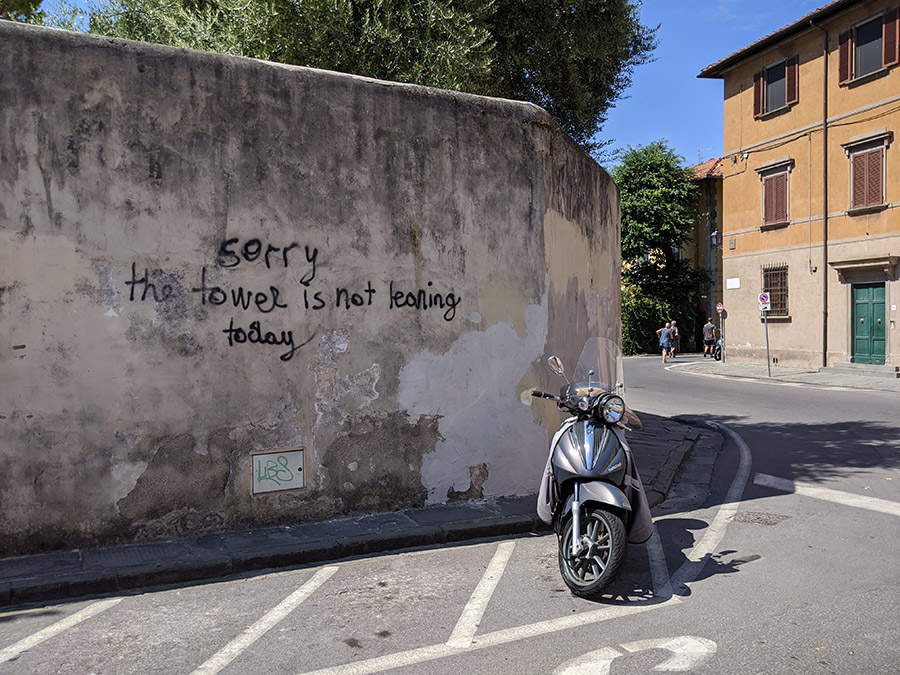
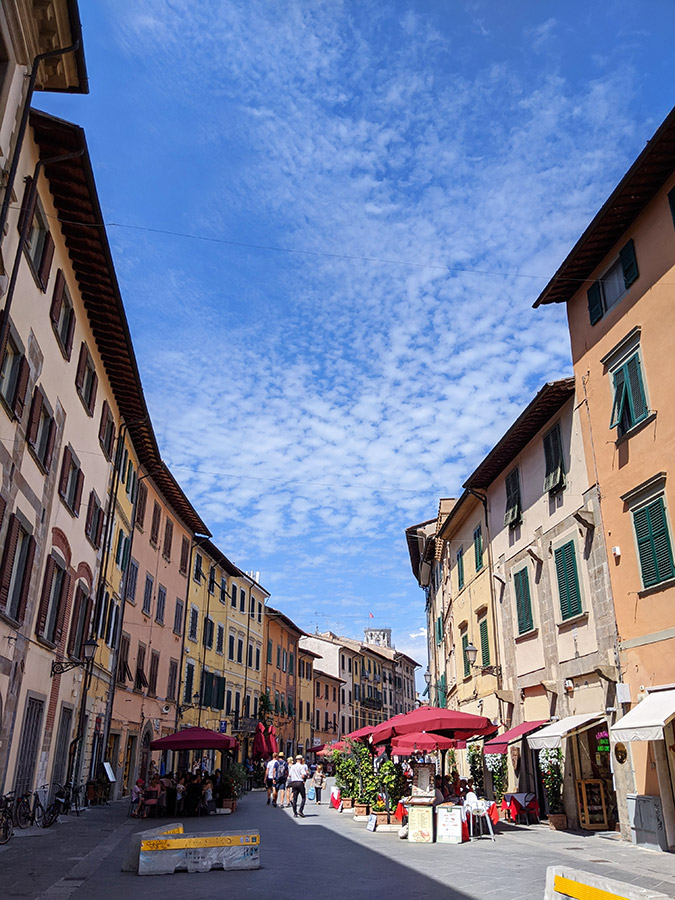
Pisa was surprisingly busy, and full of Aussies for some reason. Apparently Australian people are drawn to things that are about to fall down.
Reading about the tower, the funniest thing is that I had always imagined they built the thing, and then at some point hundreds of years later it started to lean and everybody said “Oh shit!” and then said “Eh, whatchagonnado?” and then went about their business.
But this isn’t true. It started leaning WHILE THEY WERE BUILDING IT. And not toward the end, when they were putting the bells on top or anything. The tower took like 200 years to build and it started to lean when they were building the second floor. The second floor! Did they stop and say “Whoa whoa whoa, who’s the asshole who picked this sandy spot to build a tower? Maybe we should stop and rethink this. Or at least make a deeper foundation or something?” Nope, they did not say any of that at all. They decided “Fuck it, we’ve already started” and compensated for the lean by building the walls higher on the leaning side, so the tower would curve into a somewhat straight alignment.
Of course it kept leaning, and leaning, and leaning until 1993 when people said “Oh shit, you know what, that thing’s gonna fall on my house where my dog lives.” And so they piled several tons of weights on one side to get the tower to stop doing that, and then dug out a bunch of soil from under the raised end. I’m not an expert in fixing leaning towers (don’t worry, you’re not the first person to assume I was) but digging the hole deeper wouldn’t have been my first instinct for fixing this problem.
It turns out they had an opportunity to make the tower straight while they were doing this, but nobody wanted that since it’s a tourist attraction now. And it’s not like they’re wrong, I wouldn’t have gone there to see the formerly leaning tower of Pisa.
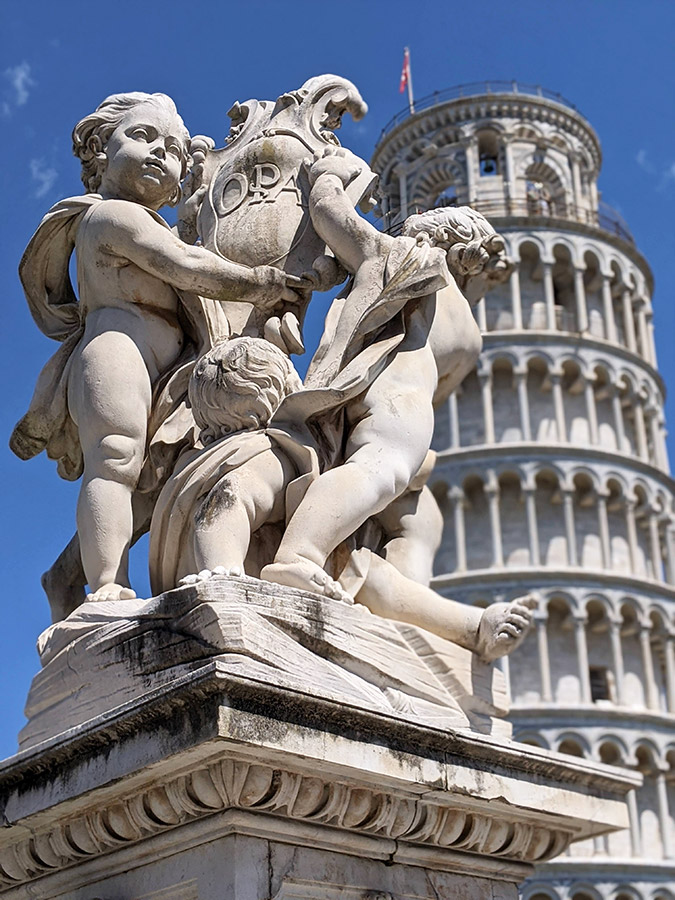
Impressive military men in impressive vehicles guarded the base of the tower, discouraging any terrorists who might be thinking about staging a catastrophic attack to straighten the tower.
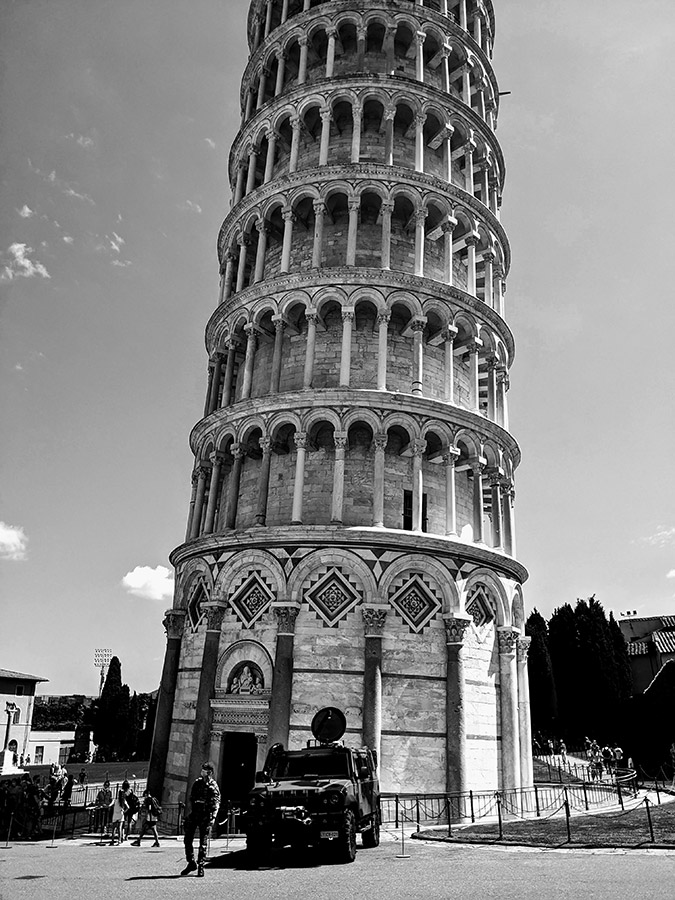
As I was soon about to learn, you can’t just rock up and climb the tower whenever you feel like it, there are tickets for that shit and a waiting list and all kinds of bummery stuff. Once I got my ticket for the first available slot later that afternoon, I realized I had a few hours to kill. So I decided to check out the Cathedral. See, because the Leaning Tower is just the bell tower for a Cathedral that nobody cares about.
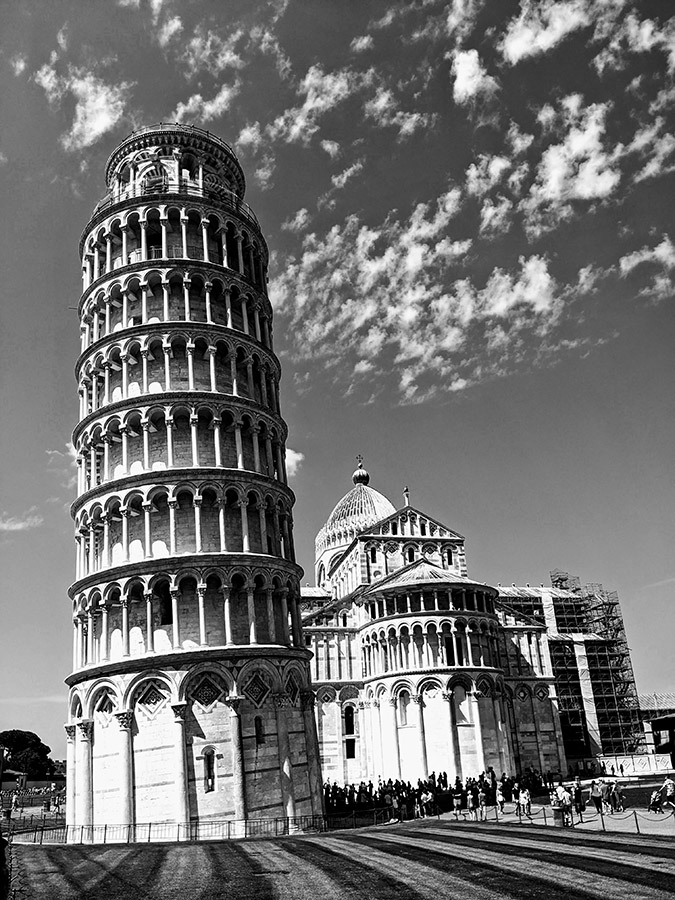
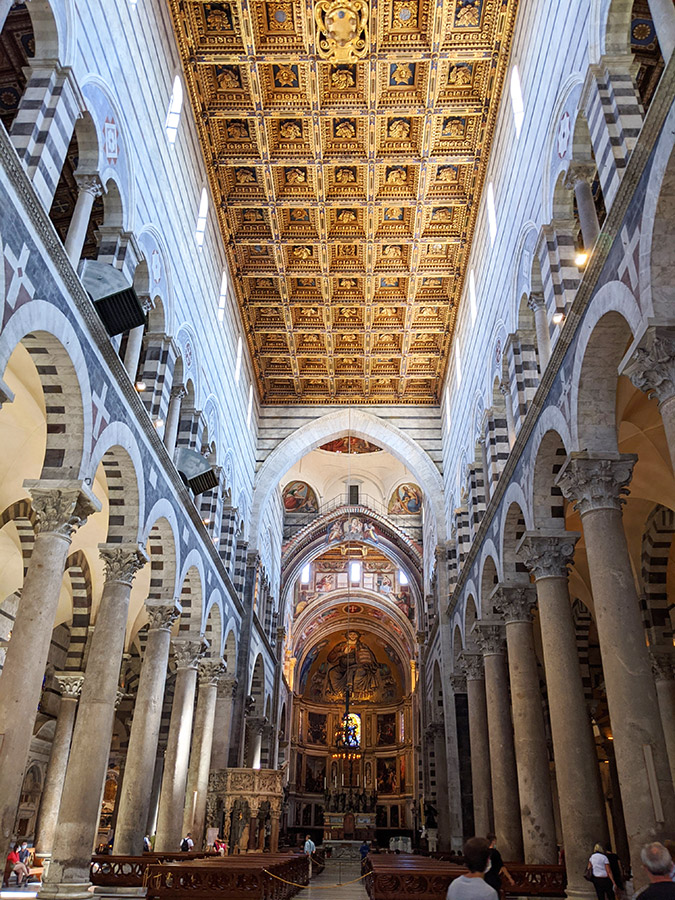
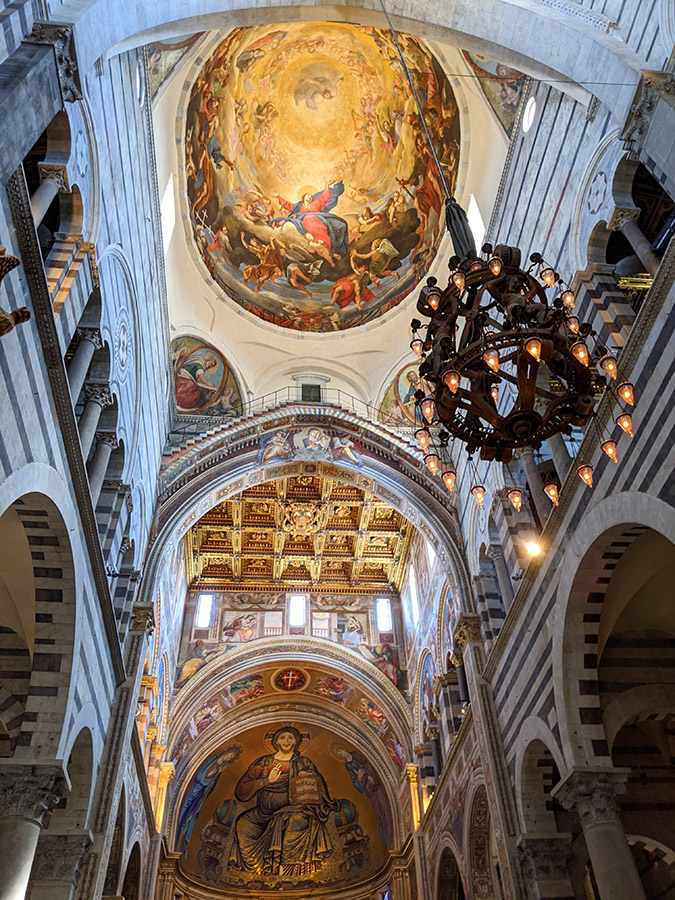
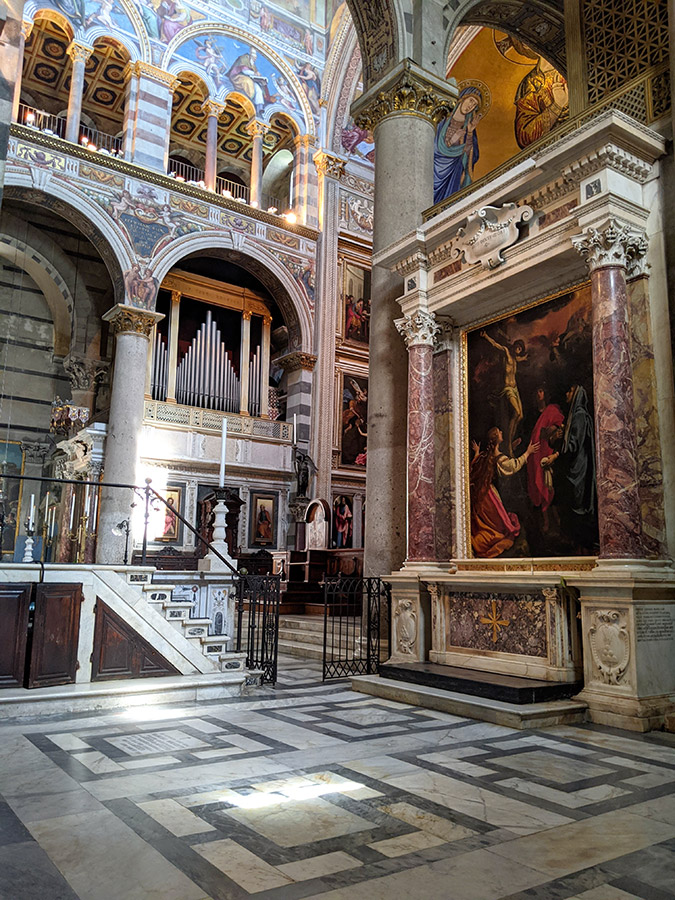
There’s also a bulbous little Baptistery, where raucous crowds can witness hot baptism action.
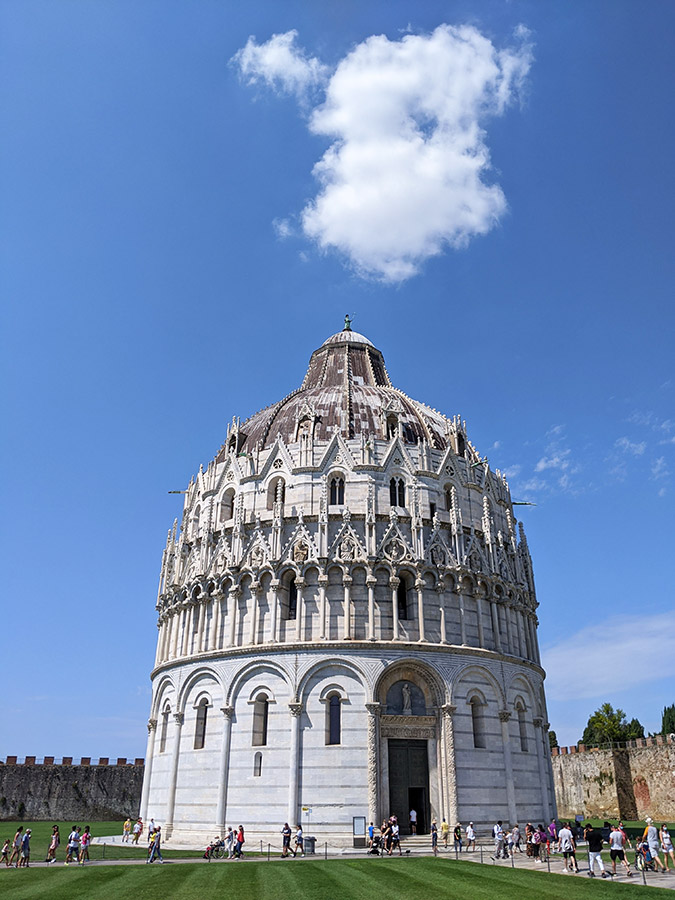
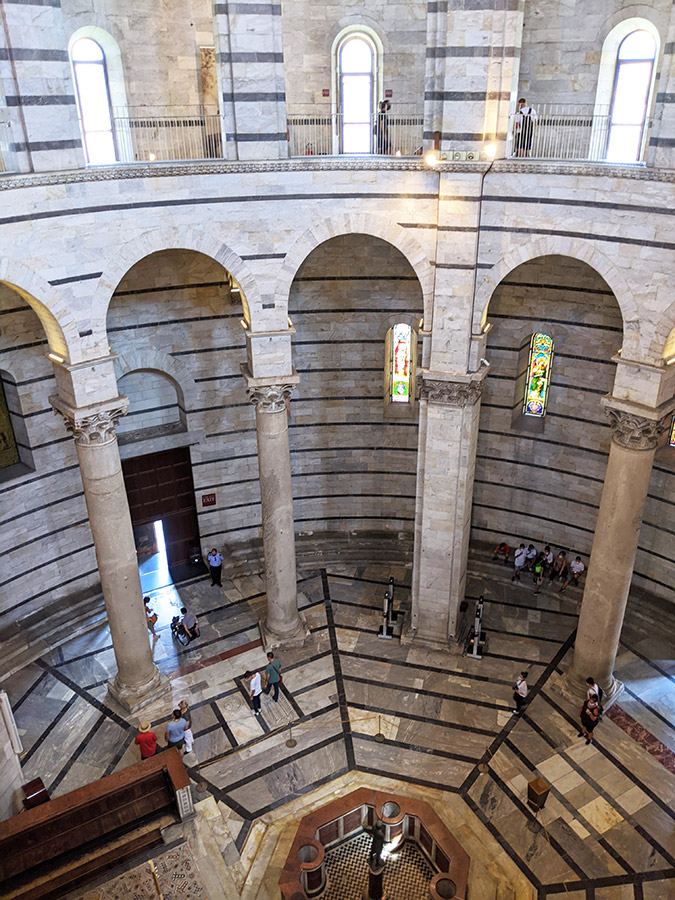
Okay, so that killed 22 minutes. Shit, what do I do now? I wandered into Pisa and got some ice cream.
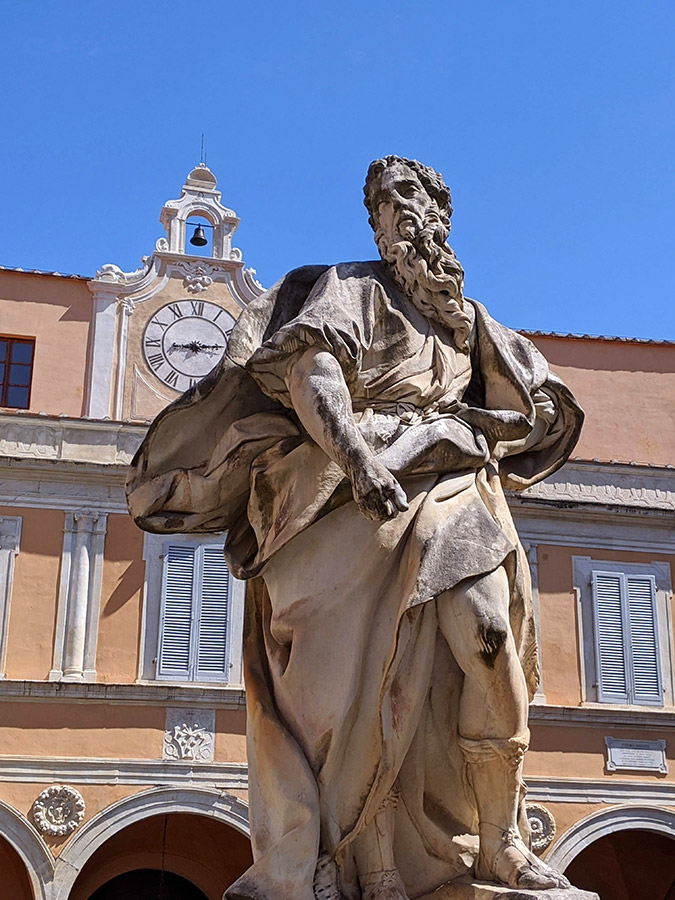
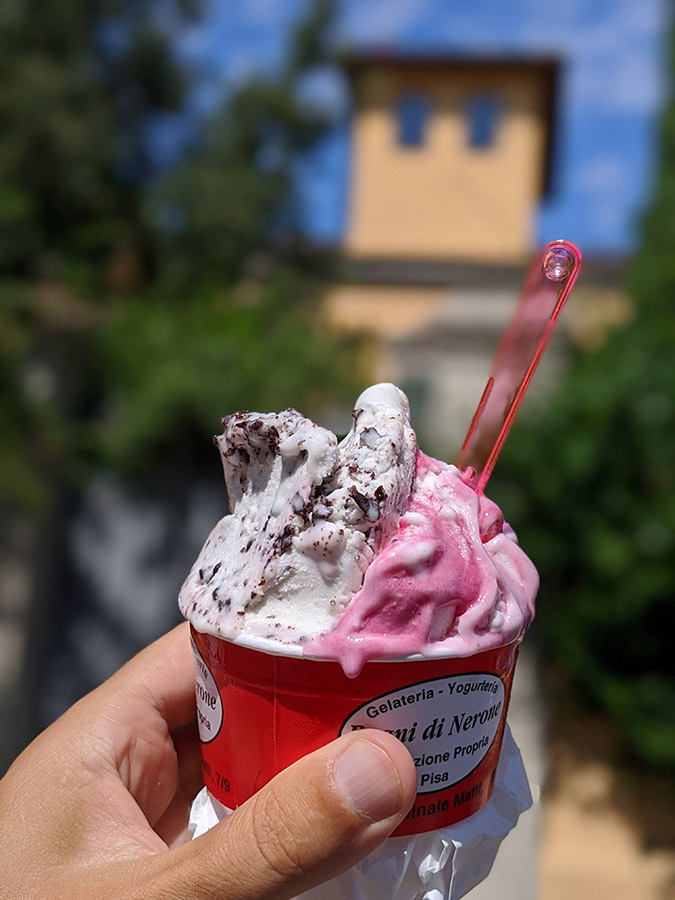
Pisa thoroughly experienced, I eventually wandered back to the tower and a guy dressed as a hoagie kept trying to talk to me.
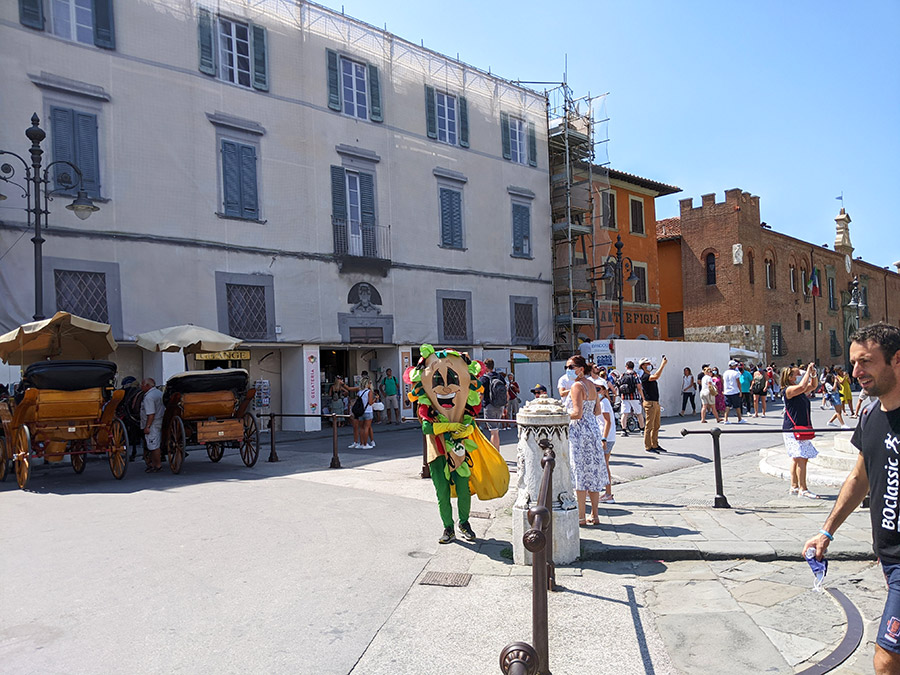
Oh my God tower, you need to let me in or fall over or something, right now I don’t care much which- Oh hey, it’s my time slot!
After my long wait to get inside, I was shocked to find that the inside of the tower was completely empty, like a grain silo. You could look straight up at the top level where the bells were.
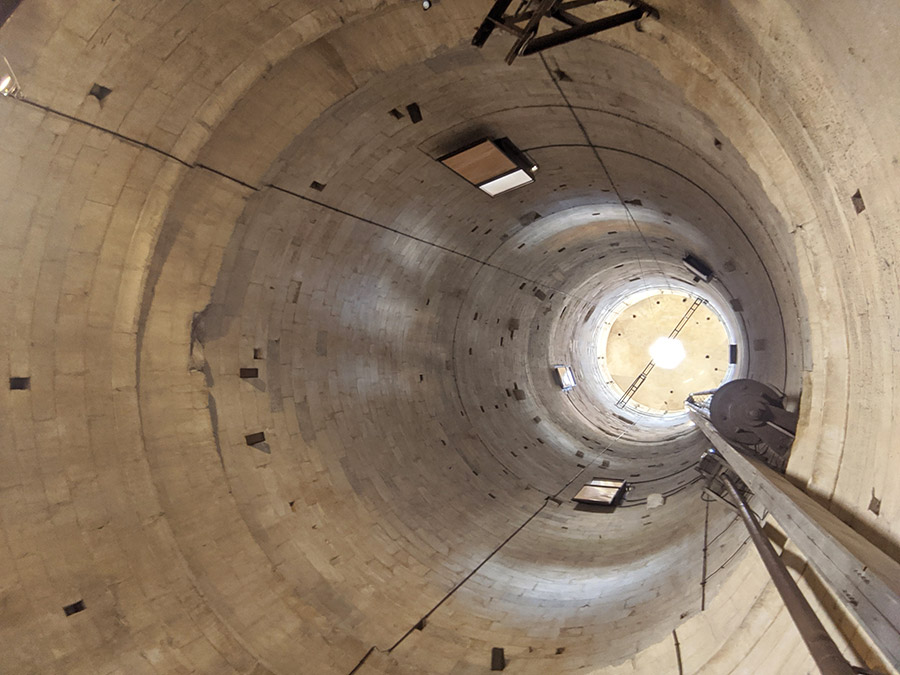
Once inside, we were required to hang proximity sensors around our necks, which would beep loudly and annoyingly if we got within six feet of anyone else in our group. I had to hand it to Italy, they were taking covid way more seriously than anywhere else I had been.
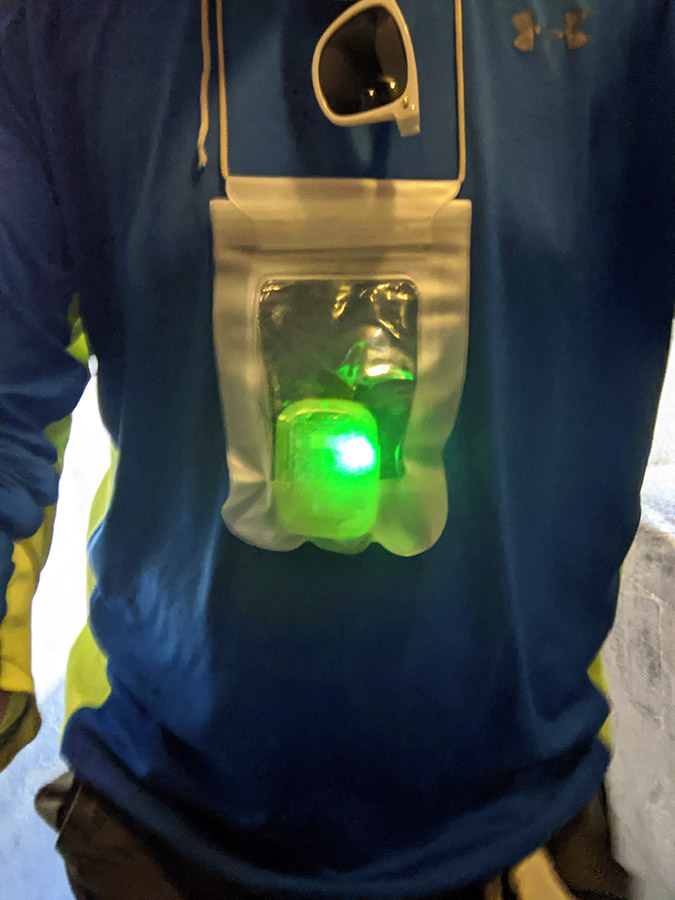
“I AM IRON MAN.”
“Mi dispiace, non parlo inglese.”
Goddammit Italy.
The stairs to ascend the tower wrapped around the inner walls in an ongoing spiral of slippery polished marble. The crazy and disorienting thing about climbing the stairs was that other than a small window at the landing of each level, you couldn’t tell which side of the tower you were on, so there were no visual cues to help you navigate the stairs constantly changing pitch with the lean of the tower. It felt a bit like being in a funhouse at the County Fair, things being just off enough to confuse and disorient you.
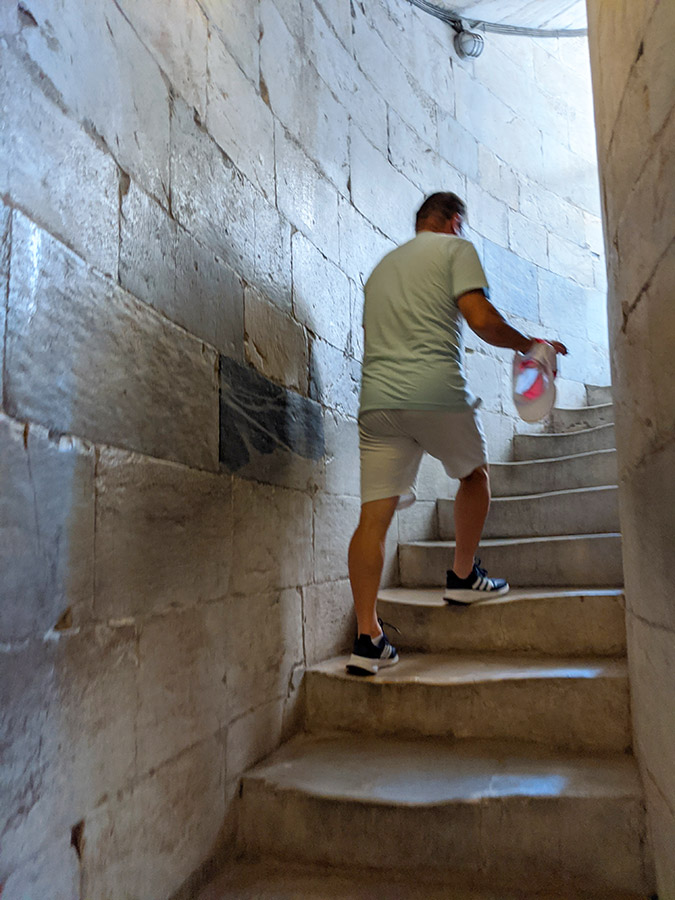
Once we reached the second level from the top, we stepped outside and took a stroll along the outside rim, taking in the view of cute little Pisa all around us.
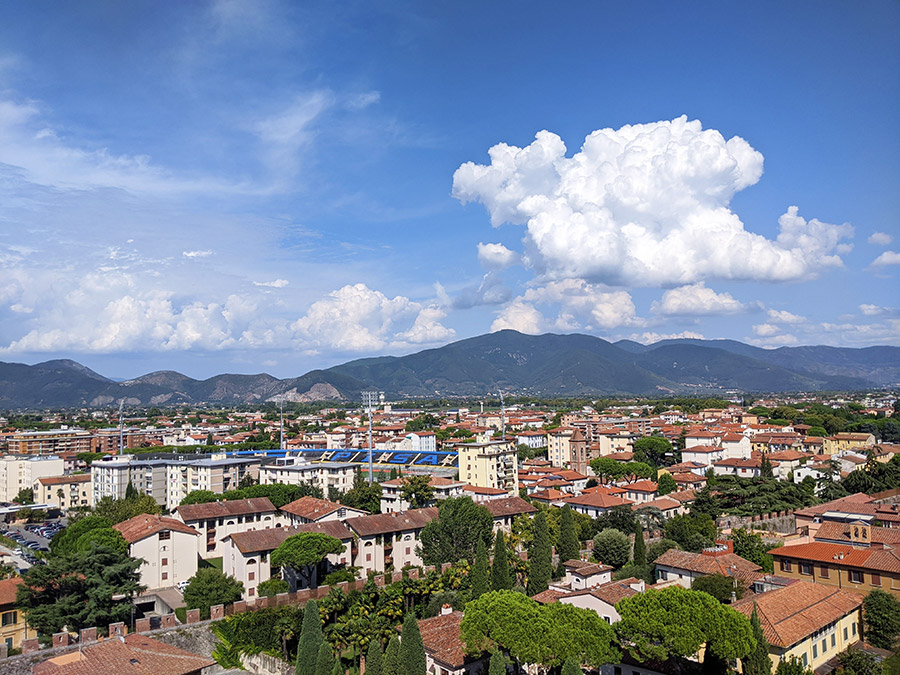
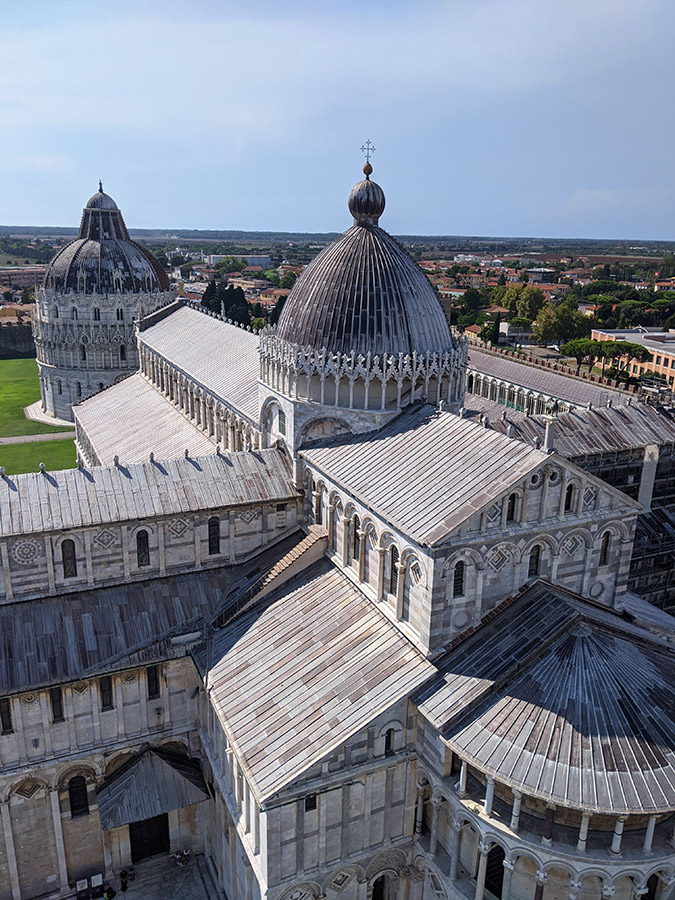
After looping all the way around the tower we came to the final staircase, a narrow little corkscrew up to the top floor.
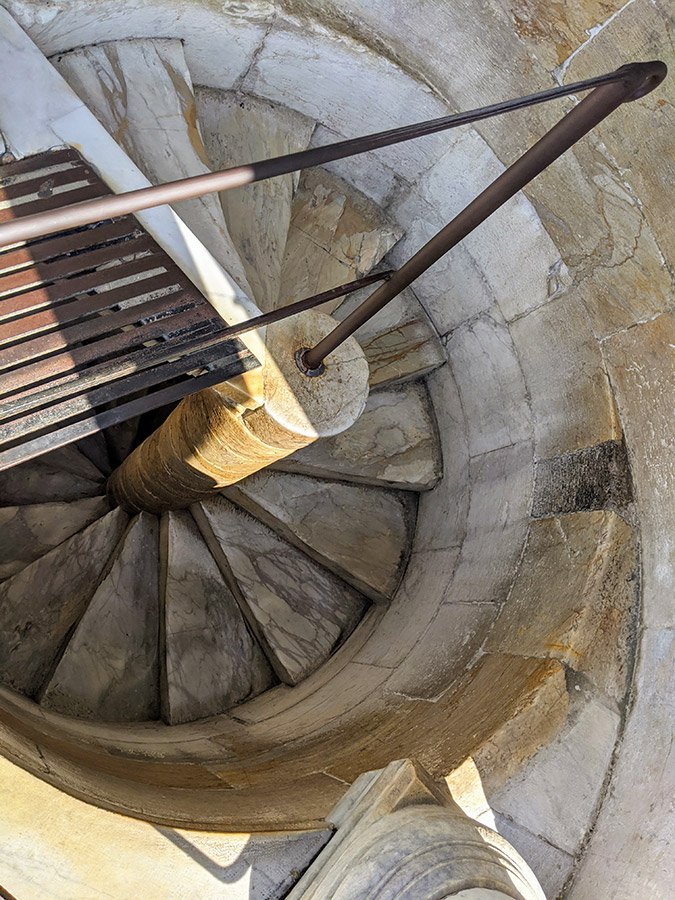
These stairs were just fucking crazy, slanted at all kinds of weird angles, and the marble was scooped out by hundreds of years of foot traffic, to where it felt like climbing up a set of bowls or bedpans that had been strewn haphazardly across a steep incline. And this was entirely separate from and in addition to having to navigate the lean of the tower itself. The steps waved and dipped like you were climbing up a castle on an acid trip.
Up top you could get up close and personal with the tower’s huge bells, which were outfitted with stirrups for Rodeo Bell Riding on Tuesday nights.
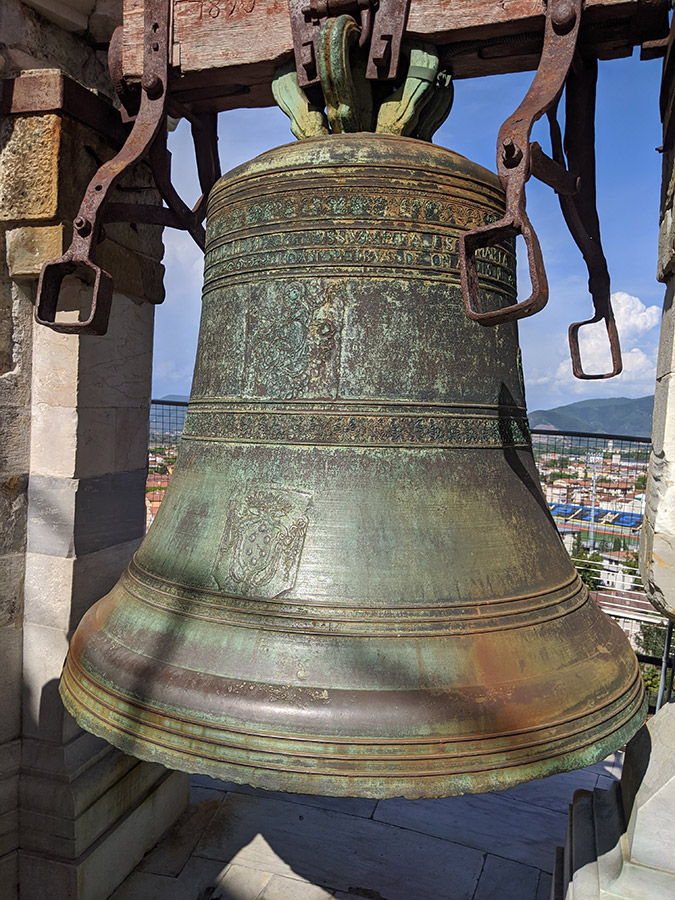
The slant of the tower felt less obvious up top, maybe it’s less steep up there or it just helps that you can see everything and orient yourself. I’d been slightly worried during the climb that up top we were all just going to slide to one end of the tower and be pinned against the railing by gravity.
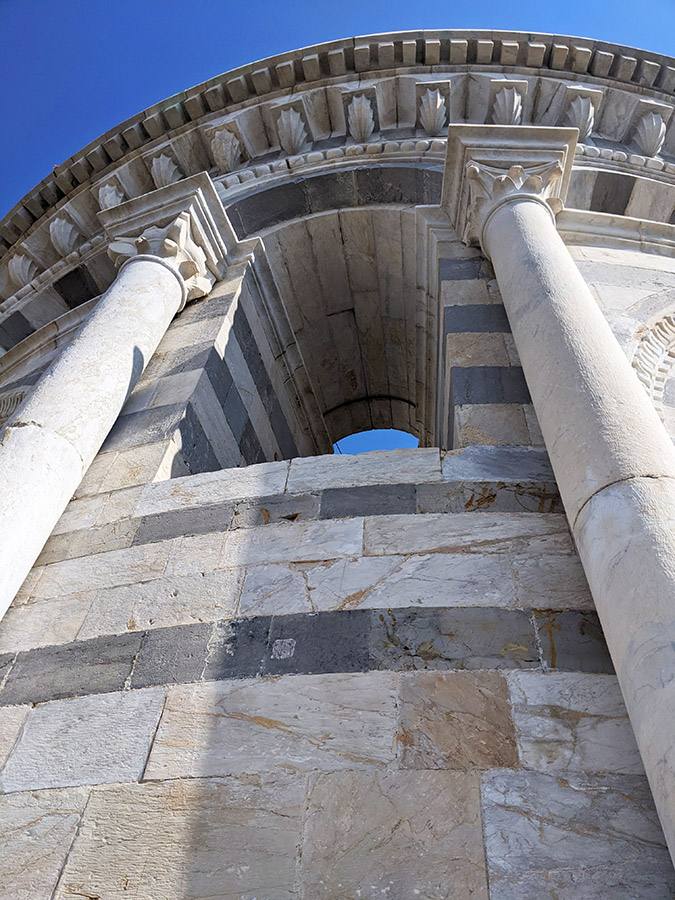
Well that was fun! What a crazy tower to climb. I suavely took out my phone to look at the time and OH MY GOD realized the only train back to Florence for several hours was leaving in 10 minutes. I looked down at the Hoagie guy waiting for me down below.
No.
And that’s how I ended up booking it down the entire Tower of Pisa and sprinting a mile and a half across the town of Pisa in the middle of the street in 9 minutes flat. If anyone needs a proximity sensor necklace I’ve got an extra one.
Buying train tickets in Italy becomes a bit of a challenge because the town names aren't actually spelled the way we spell them.
Rome? Roma. OK.
Venice? Venezia. OK getting a little harder but it still autocompletes in the search since you're starting the word the same way.
Florence?
Firenze.
OK Italy now you're just fucking with me. Why don't we just call it Firenze if that's the actual name of the city in Italy? It's like if people in other countries couldn't find New York because they call it Doberman Pinscher. Madness.
Florence is a beautiful city and one of the only places in Italy where I found good vegan food. Not sure why that was, but I’ll take it.
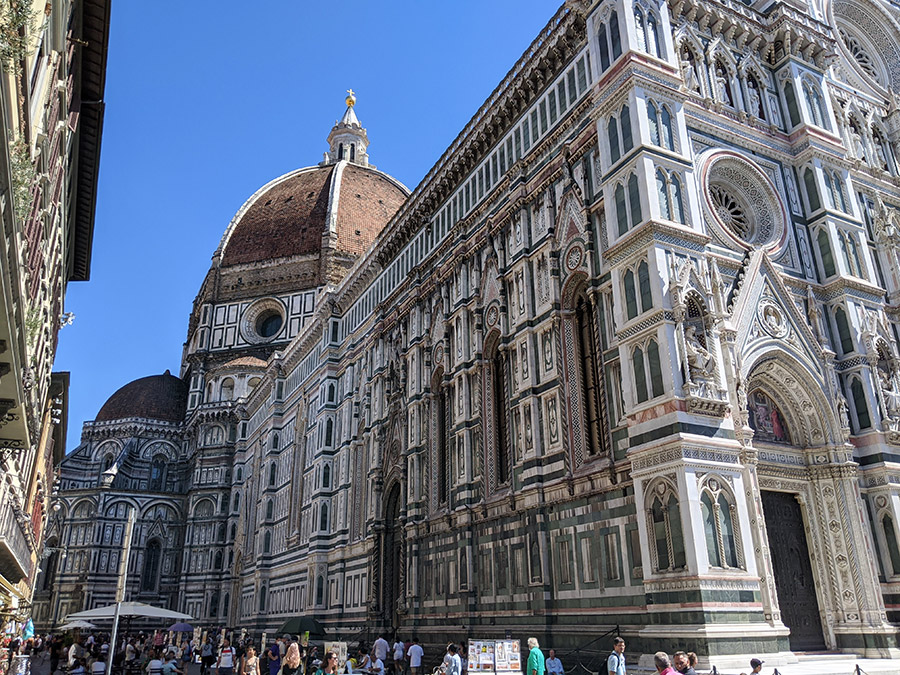
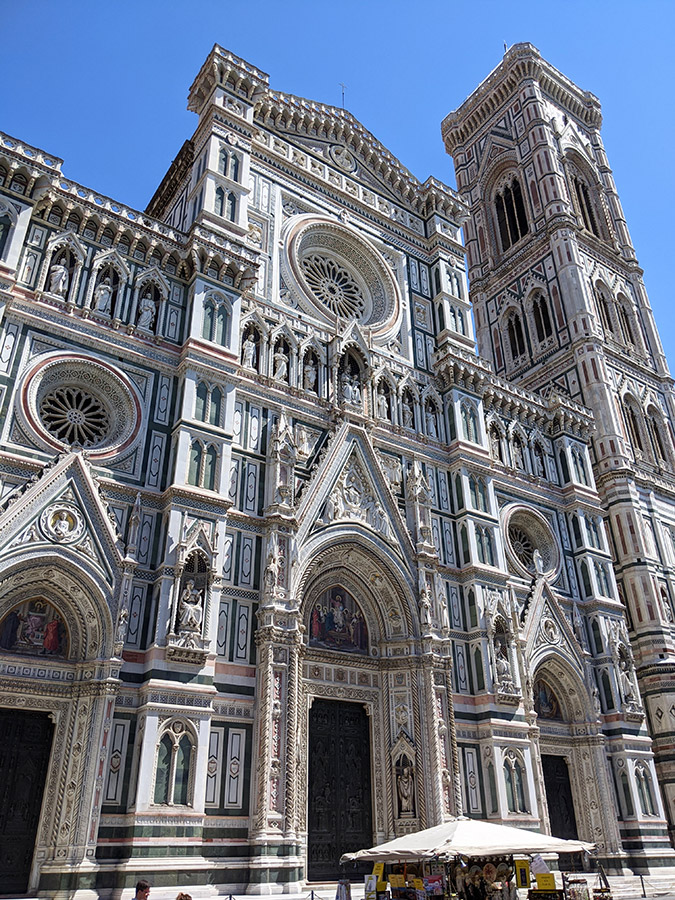
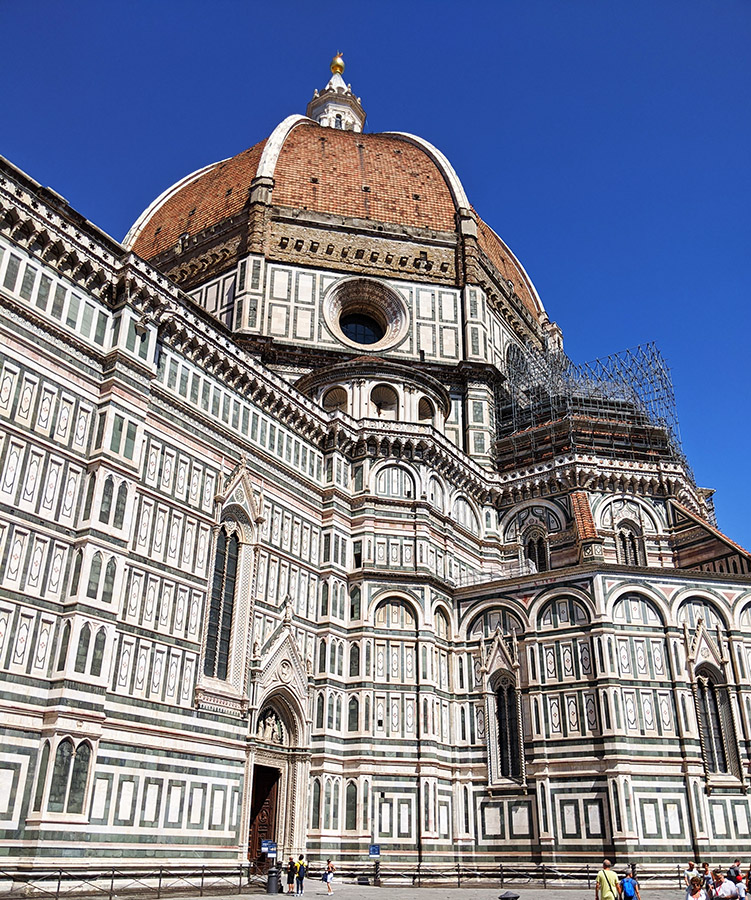
I returned to Florence again on my way back up the boot after exploring Southern Italy, and I had a brief layover between trains. I was thrilled by my ability to run out of the train station and navigate the streets of Florence by memory from my previous time there, making no wrong turns on my way to grabbing a late-night burger for my train ride up to Milan. This brough a nice feeling of homeiness to a foreign country, and it’s always amazing to me how quickly this can happen.
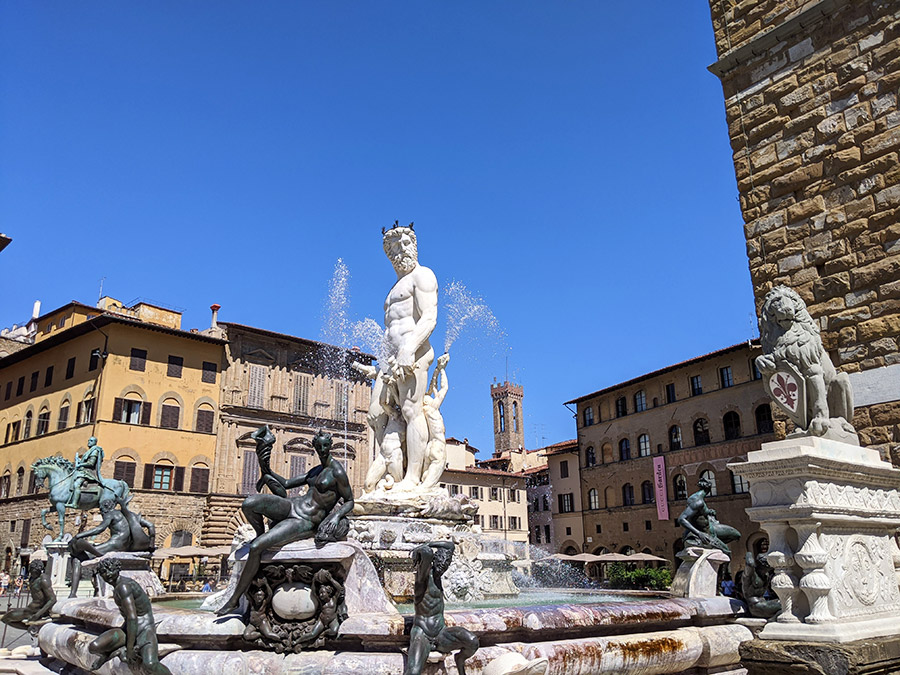
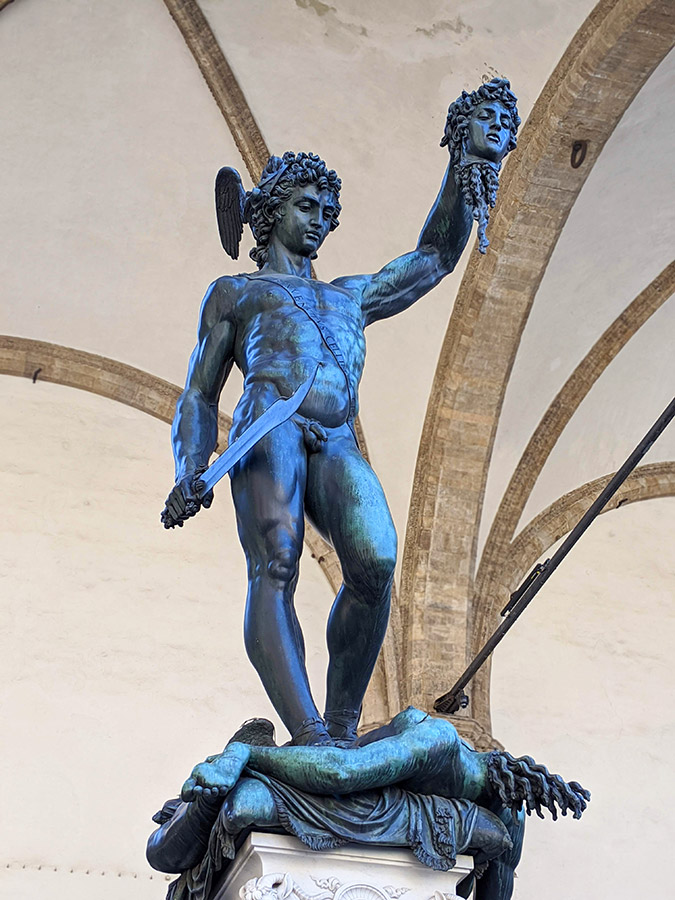
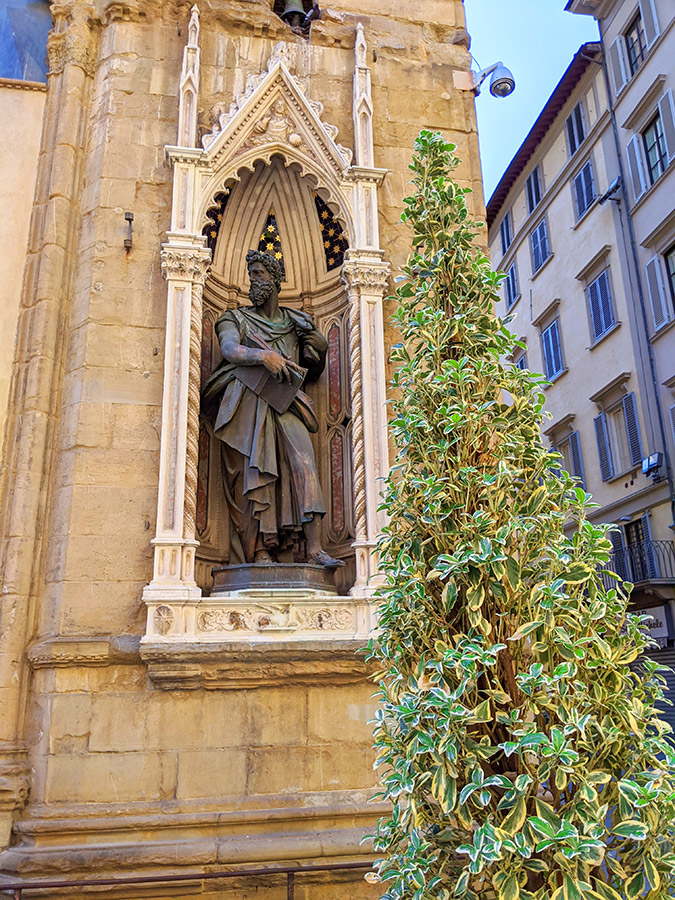
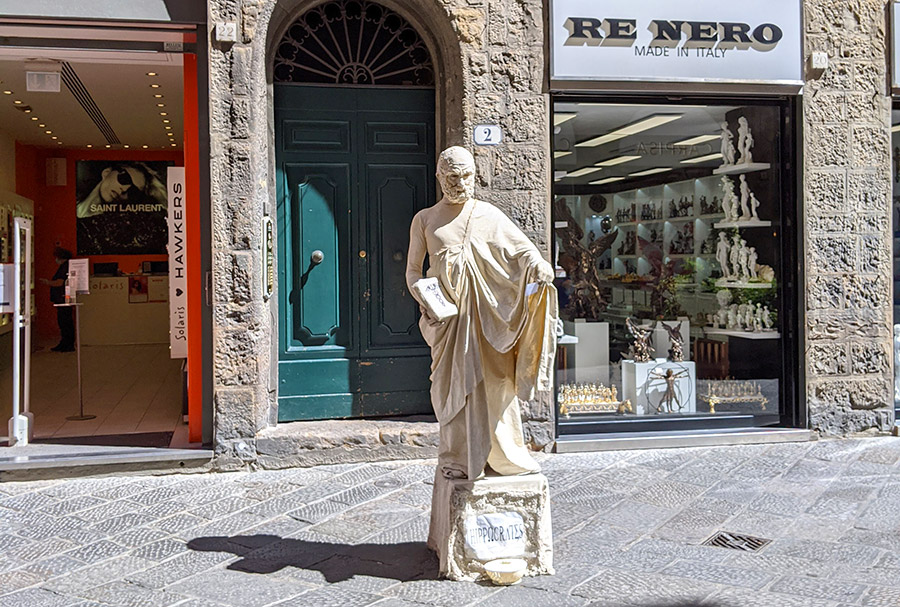
Florence is also where you’ve got to go if you want to see Michelangelo’s David. This statue is located at the Accademia Gallery, and is the most extreme example I’ve ever seen of a museum having only a single reason to visit it. There’s some other stuff there, sure, but on the whole this is like having Michael Jordan on a basketball team with the guys from Hanson.
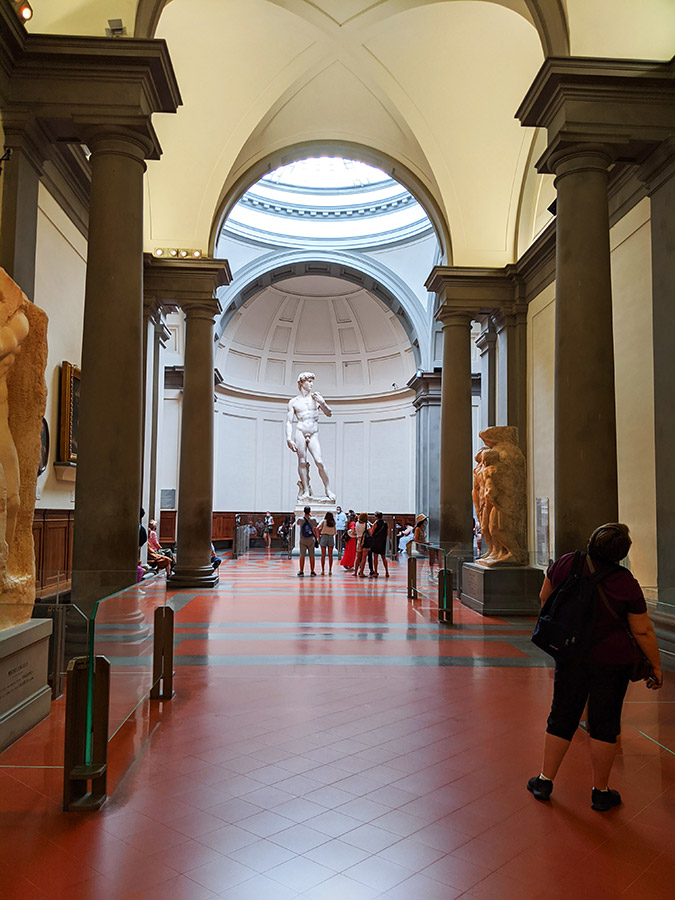
But you don’t really need a second reason to go when you’ve got Michelangelo’s David. It’s the most famous statue in the world and it’s not overrated in the least.
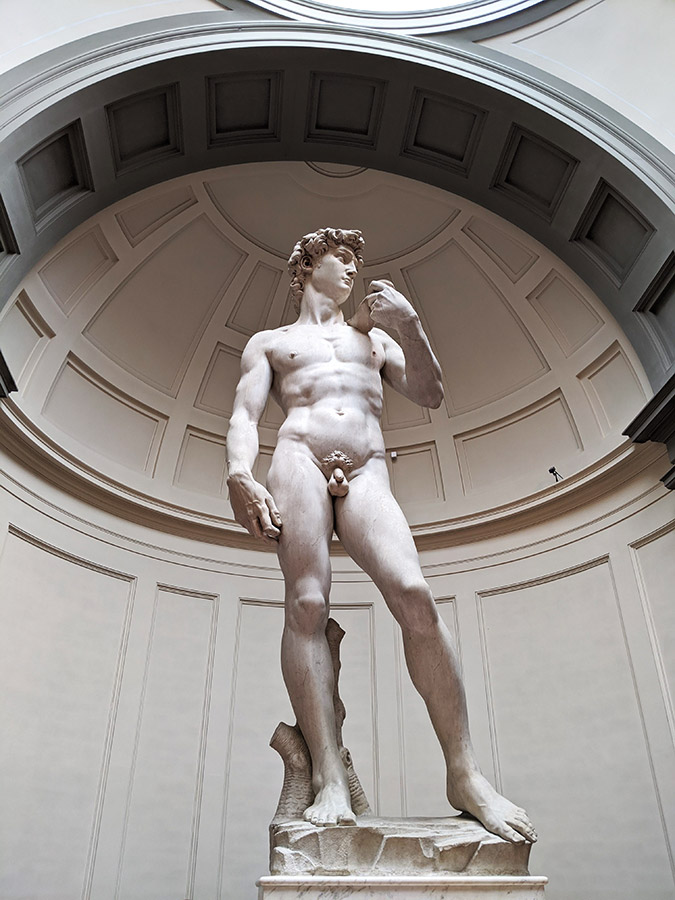
The first thing that struck me about the statue is that it’s HUGE. I guess I’d only seen photos of the statue in isolation, since I imagined it to be only slightly larger than life-sized. Nope. The goddamned thing is 17 feet tall, and it feels even bigger perched upon its 8 foot tall base.
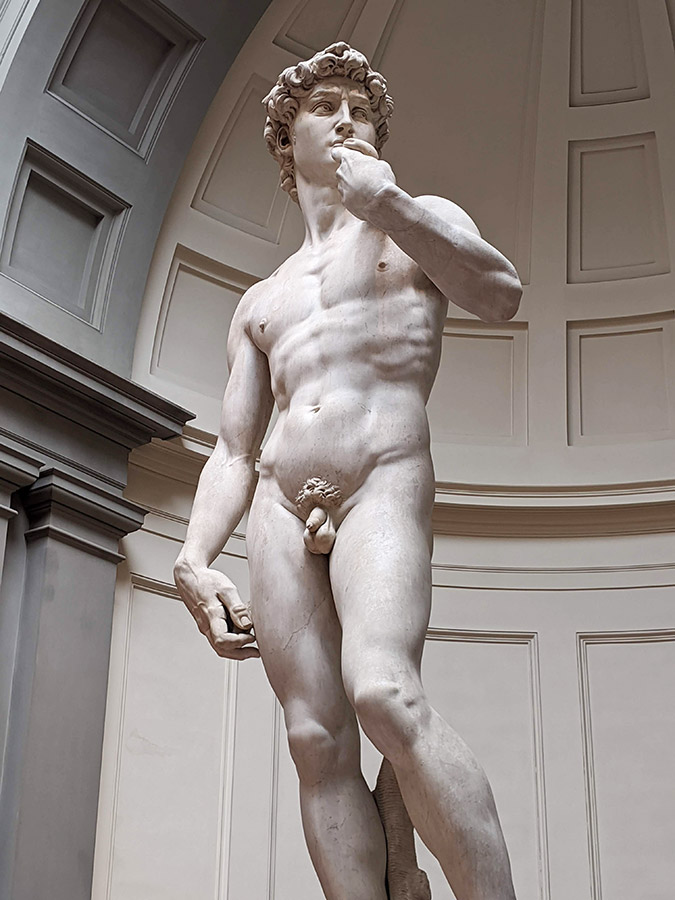
The statue was originally commissioned by the overseers of the Florence Cathedral, who wanted a series of figures from the Old Testament to decorate the roofline of the cathedral. Agostino di Duccio was chosen to sculpt the figure of David, but after three years he said “F this, I’ve got drinking to do” and abandoned the huge piece of marble with roughly carved out legs for everybody else to deal with. The massive block of marble sat unfinished like that for the next 36 years, most of that time sitting out in the rain on the cathedral lawn. Eventually a young Michaelangelo convinced everybody that he was the man to finish that soggy thing, and two years later, he did.
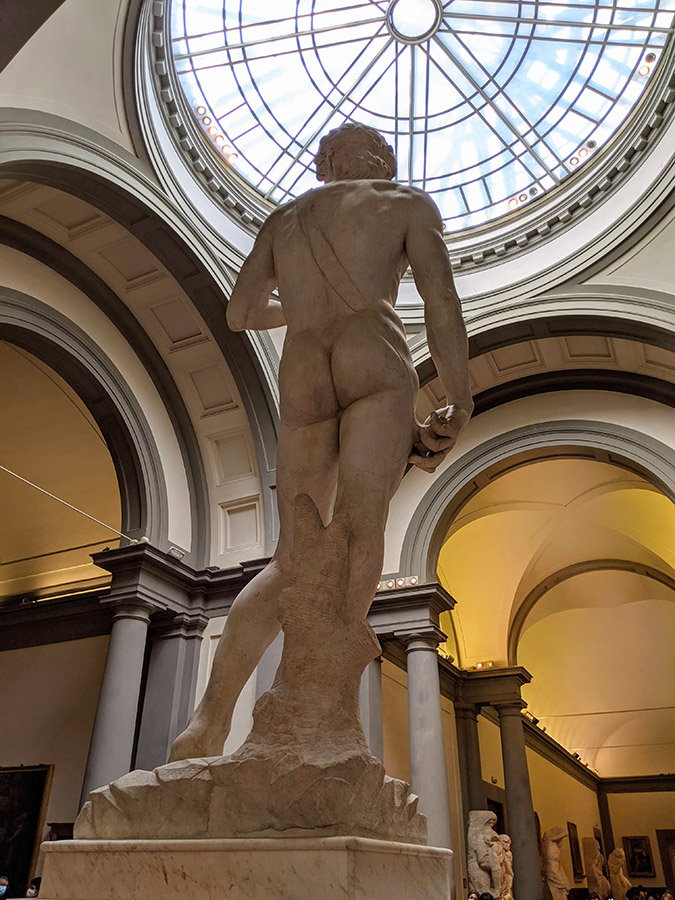
Of course then they realized the statue weighed six tons and would collapse the cathedral roof if they tried to hoist it up there. Since the defiant figure of David represented how Florence felt about those a-holes down in Rome, it was decided to put the statue in the front of the town hall, the Palazzo Vecchio, with David's eyes glaring toward Rome. There it stood for about 370 years, until people realized the massive thing was sinking into the ground and causing one of the legs to crack, at which point it was moved to its current home inside the Accademia Gallery.
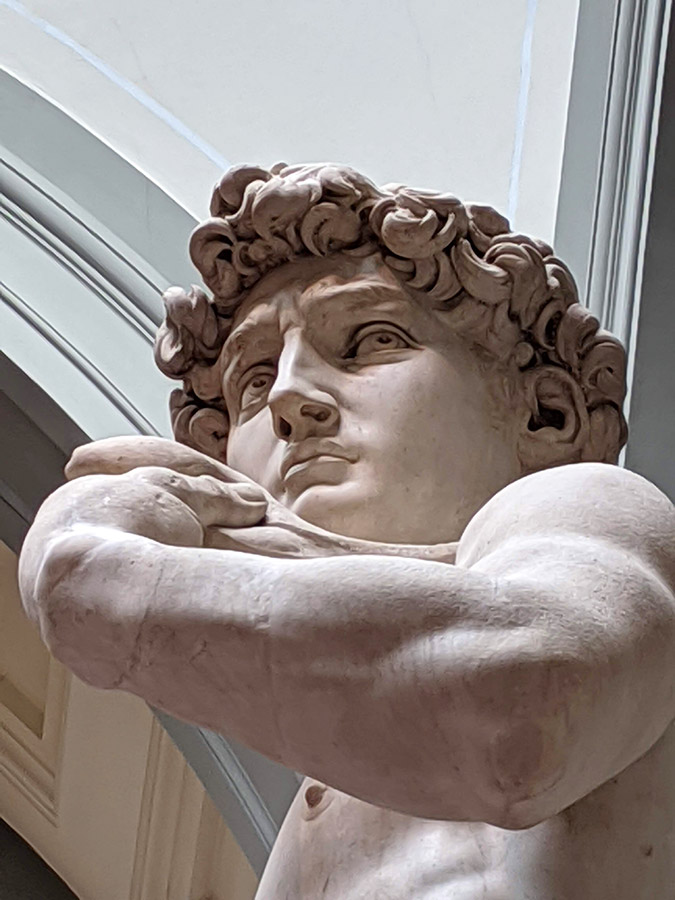
David appears to be depicted before his battle with Golaith, his face and muscles tense, his sling at the ready. The sculpture has a beautiful sense of life to it, something I had to see in person to really appreciate. David’s bones and muscles strain against his skin in a way that defies your knowledge that this is one solid block of marble.
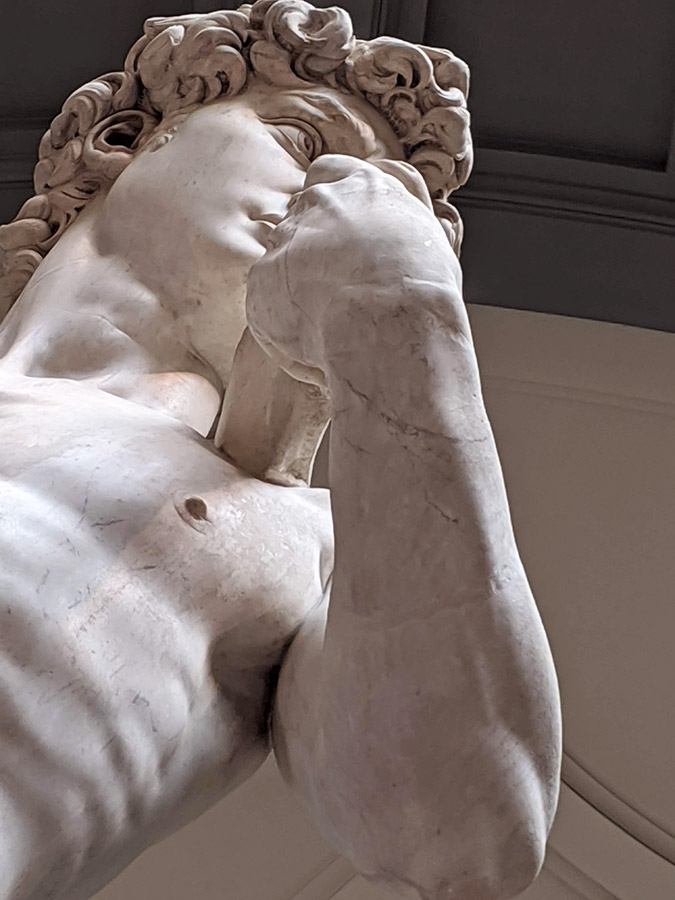
In 1991 a crazy dude, who had snuck a hammer into the gallery under his coat, started going Donkey Kong on David’s left foot before he was dragged to the ground and subdued. He claimed the ghost of a Venetian woman from the 1600s told him to do it, and was promptly shipped off to a mental hospital. After he got out, he damaged a fresco in Preto. He got out again and knifed a Renaissance painting. After he was released from the hospital a third time, he Sharpied a Jackson Pollock painting in a Rome museum. He’s out again now. I’m not an expert in such things but Italy may want to stop taking this guy’s word for it that he’s feeling much better now. Anyway, I thought David’s foot looked pretty good, all things considered.
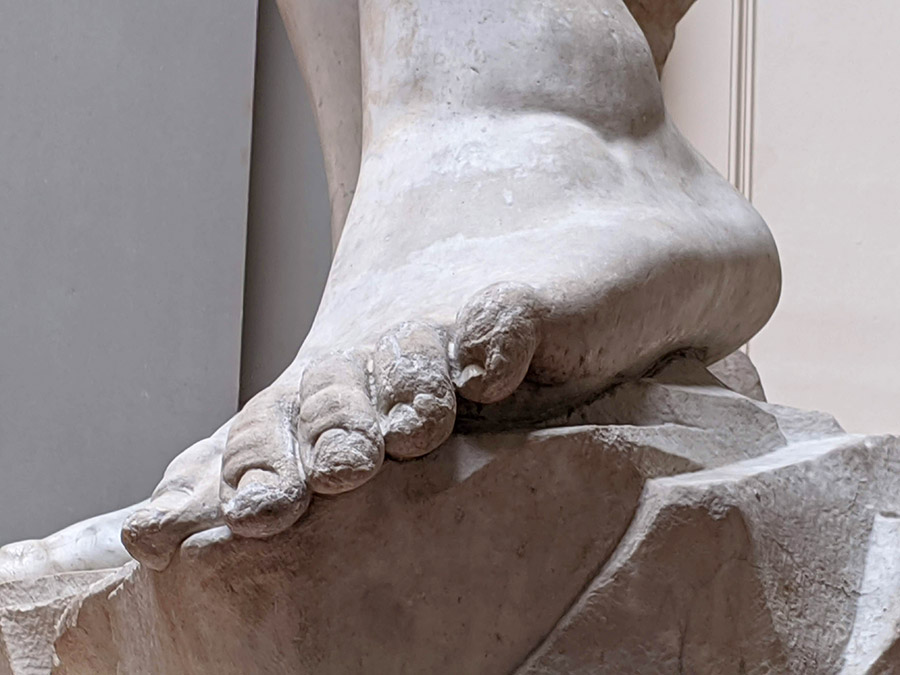
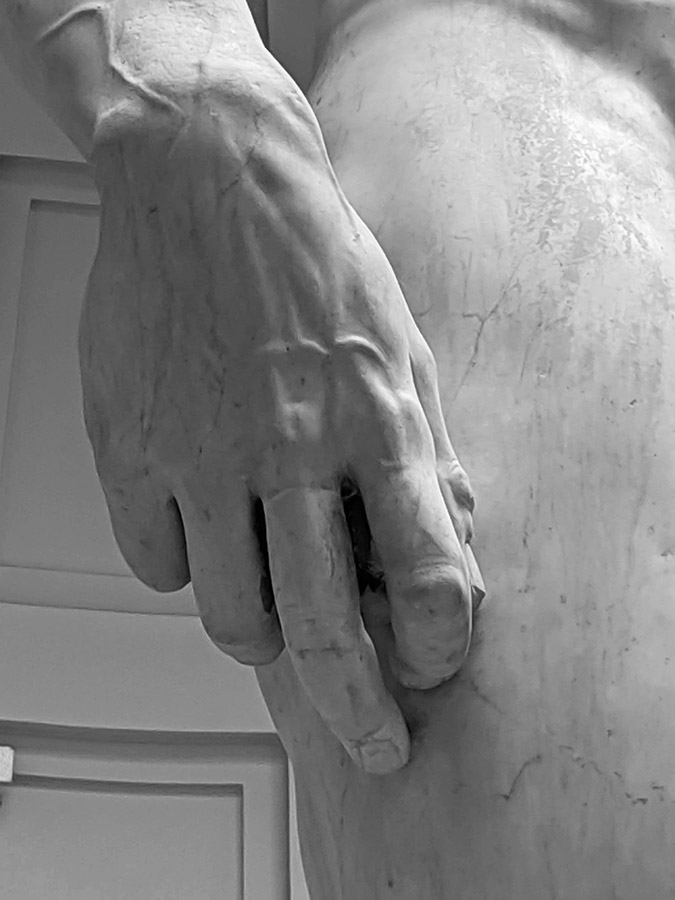
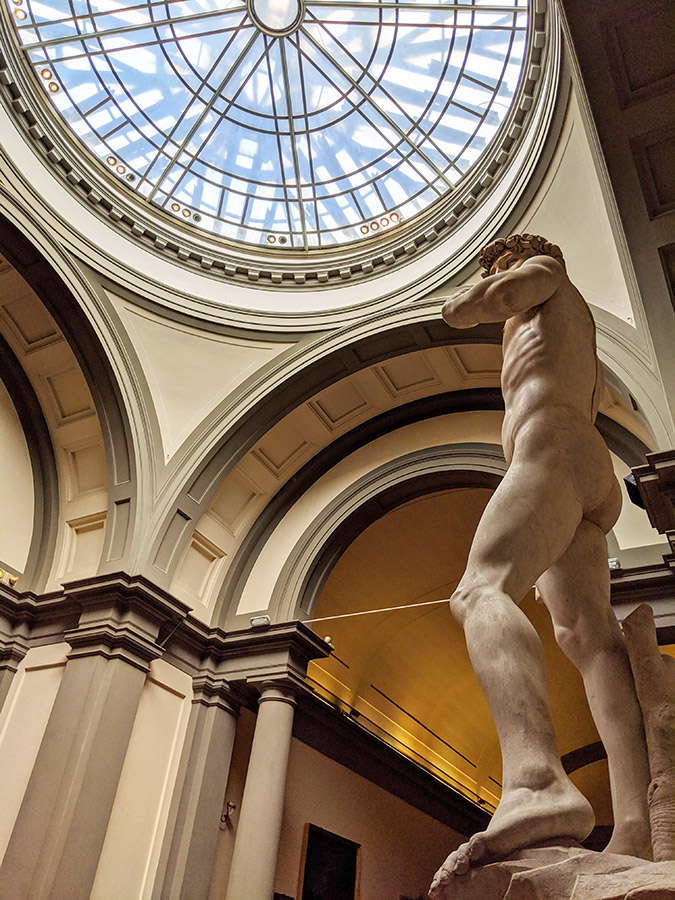
A replica of David stands outside the town hall now, where the original once stood long ago. I found this interesting to examine since it’s a very faithful copy, and yet is still missing the lifelike je ne sais quoi that makes the original what it is.
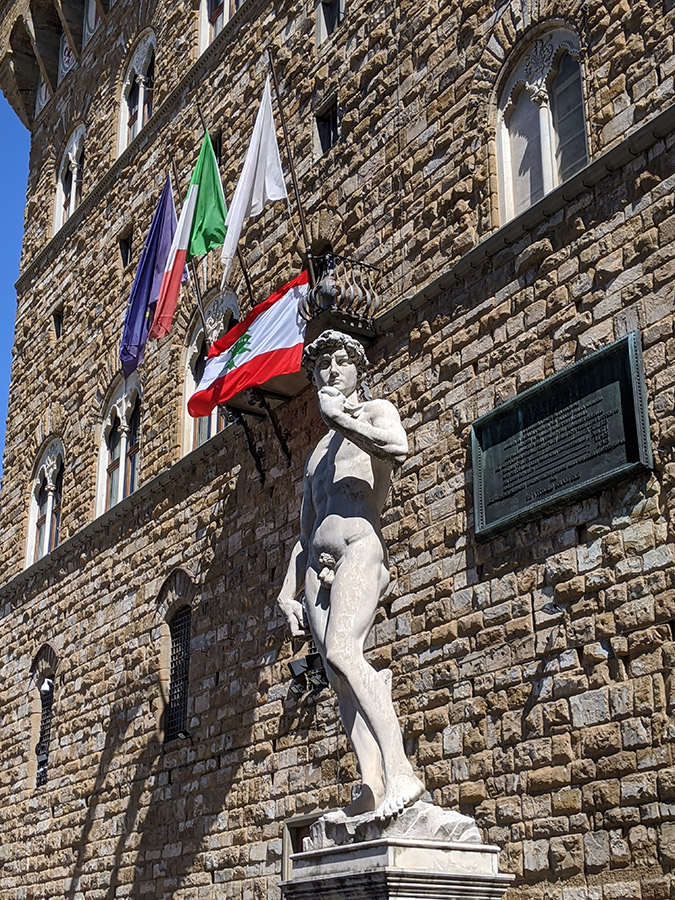
The Uffizi Gallery is a massive art museum housed in what used to be offices long ago (Uffizi=office). 50% of the paintings at the Uffizi are of Mother Mary and the baby Jesus. The other 50% are of Jesus being taken down off the cross.
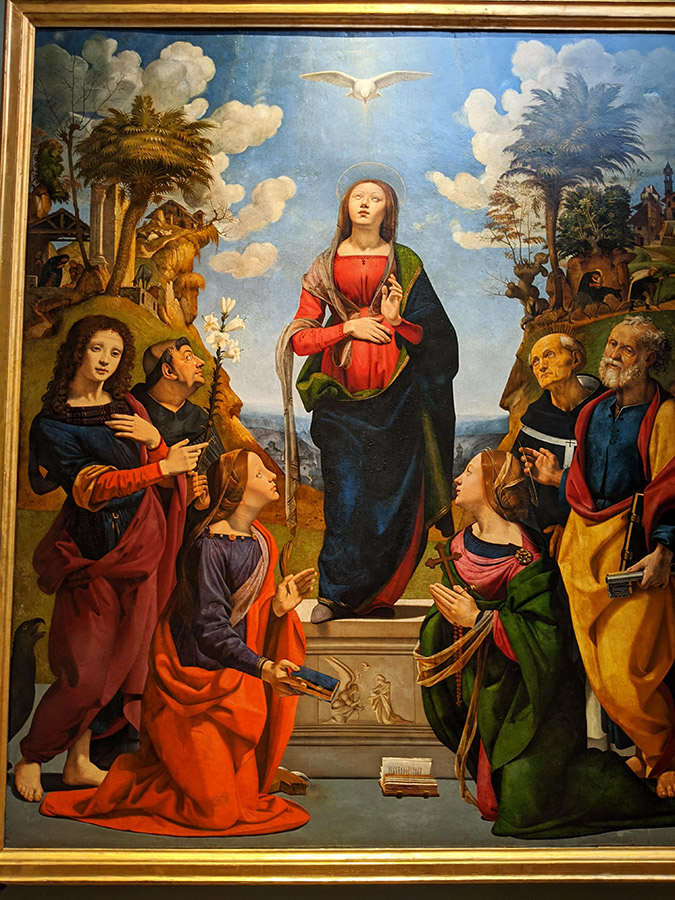
"Buongiorno sir, welcome to the Uffizi Gallery."
"Hey there. You got any paintings without Jesus in them?"
"Yes of course sir, right through that door marked EXIT."
"Hey! There's a Jesus painting out here!"
*sound of door slamming*
Thankfully there was a rounding error that allowed for seven non-Jesus paintings in the gallery, all of which are very good. I was honestly a bit sour on the Uffizi until I hit the Botticelli section. He painted plenty of Jesi to meet his quotas, but in his spare time he slapped together the mythological works he's most famous for today, The Birth of Venus and Spring. AKA Naked Chick Riding a Clam and Forest Orgy.
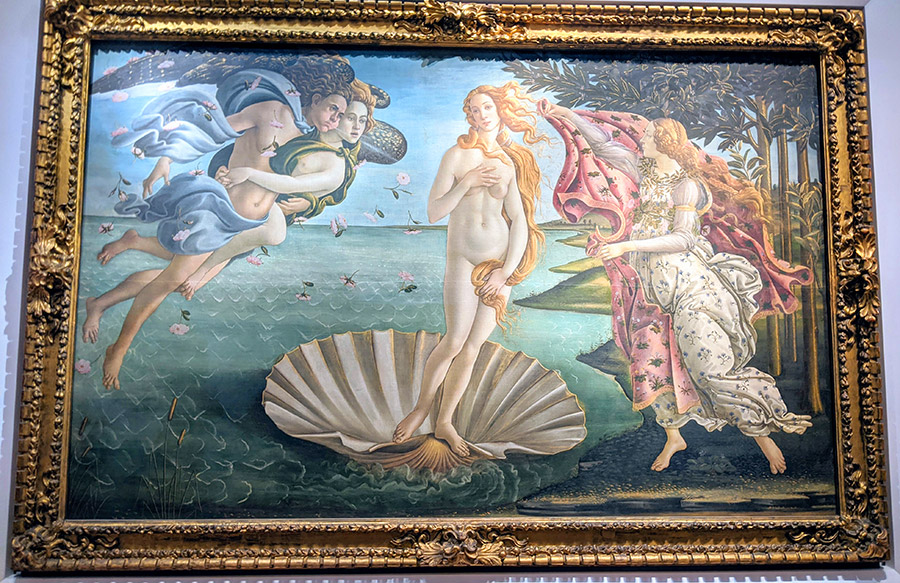
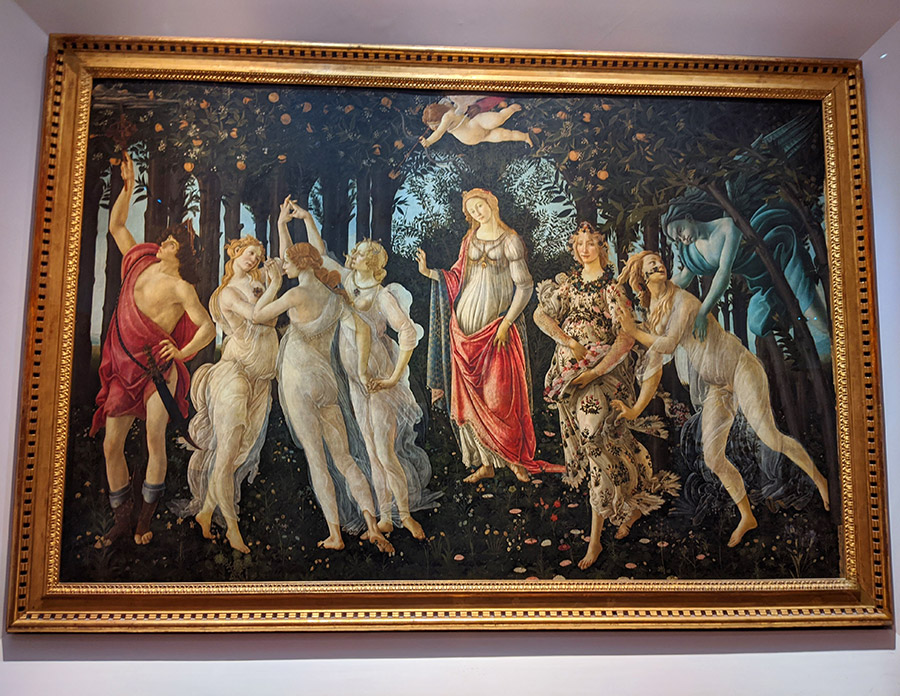
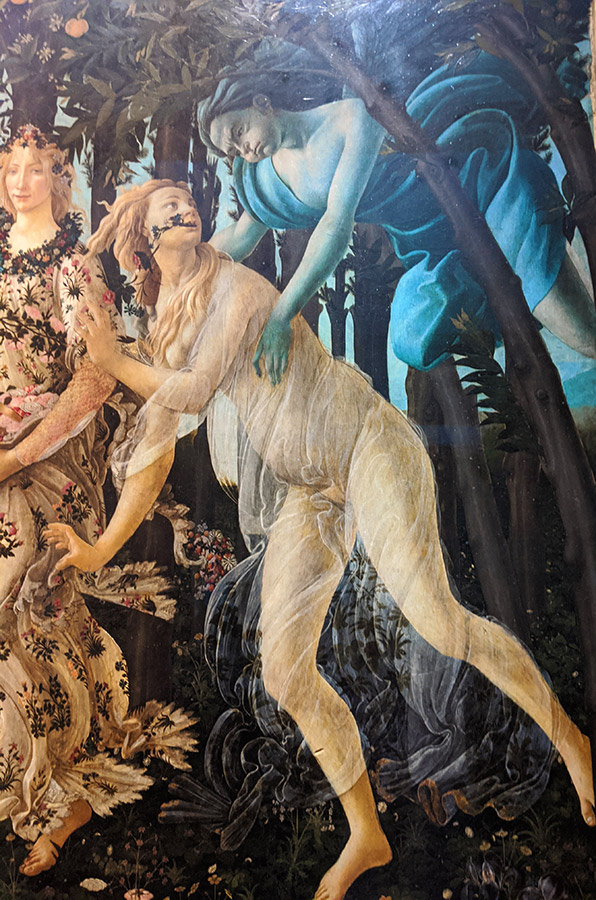
I'd never been much into Botticelli before, but seeing these paintings in person I was struck by the delicate beauty of the faces and the wonderful soft, translucent colors. I'd seen photos of these works tons of times, but in person they had a different quality that I found enchanting, something enigmatic and ephemeral that drew you in. I sat down in the museum and read an article about Botticelli's life on my phone, and was fascinated by how he was basically forgotten after his death for hundreds of years until his work was rediscovered in the late 1800s.
I'm fascinated by the capriciousness of what we consider great art to be and how that changes over time. Botticelli was much more successful during his lifetime than Van Gogh, but had to wait much longer after his death to enter the roster of officially great painters, to where we'll spend a vacation day crammed in with sweaty strangers to see his work.
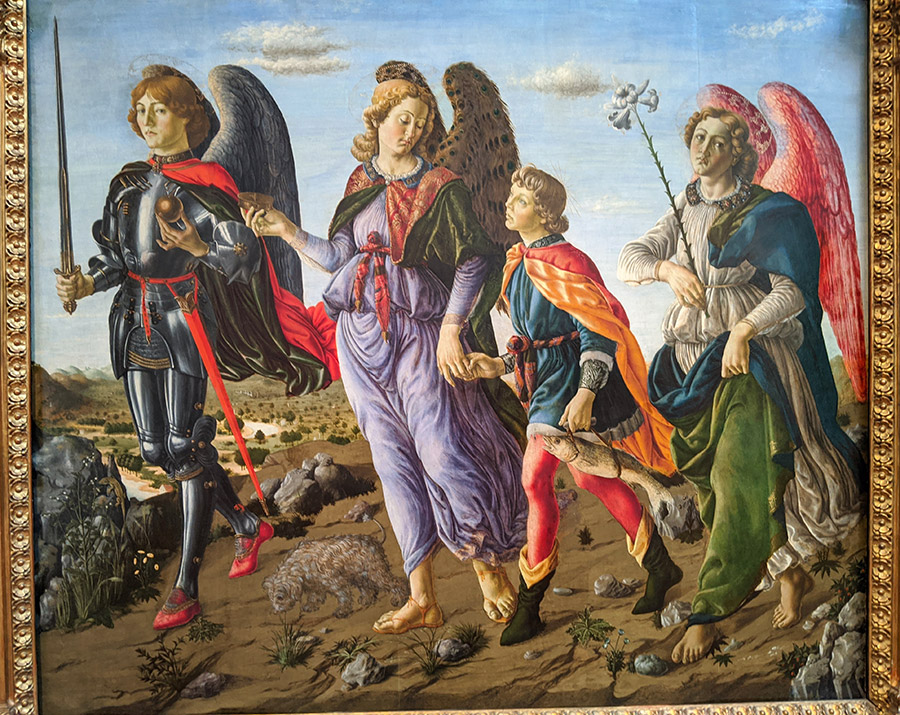
I loved this painting of Archangel Michael and his snazzy shoes and his shy little dog.
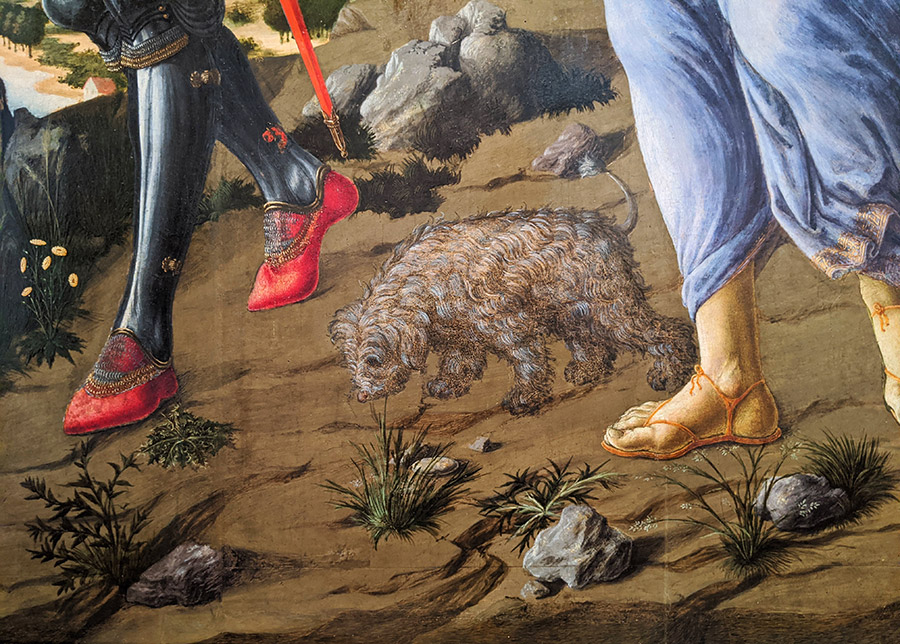
I also loved that he painted himself into Adoration of the Magi just for shits.

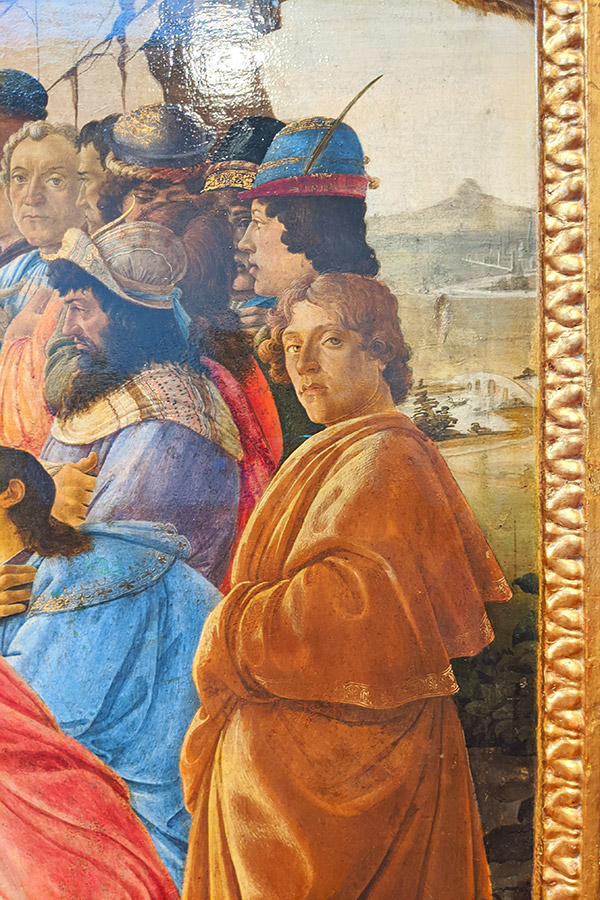
I wondered if he'd be surprised to see that the small number of mythological paintings he did were much more well-known today than all the rest of his work combined. These were huge oddities at the time as no one was painting mythological scenes in the 1400s, let alone on this large scale.
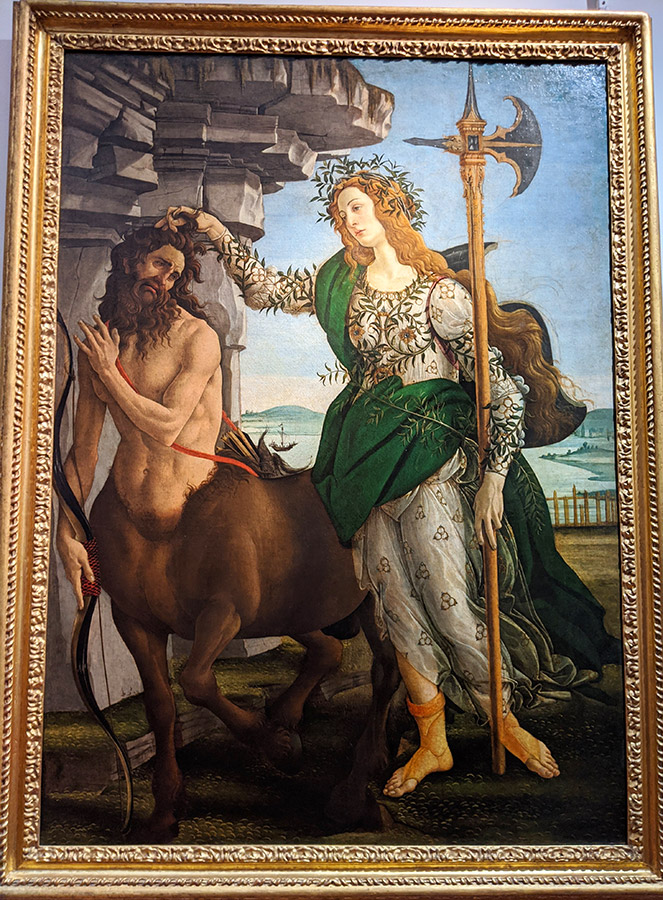
His first masterpiece was Fortitude, one of seven paintings of the virtues, all represented by well-dressed ladies.
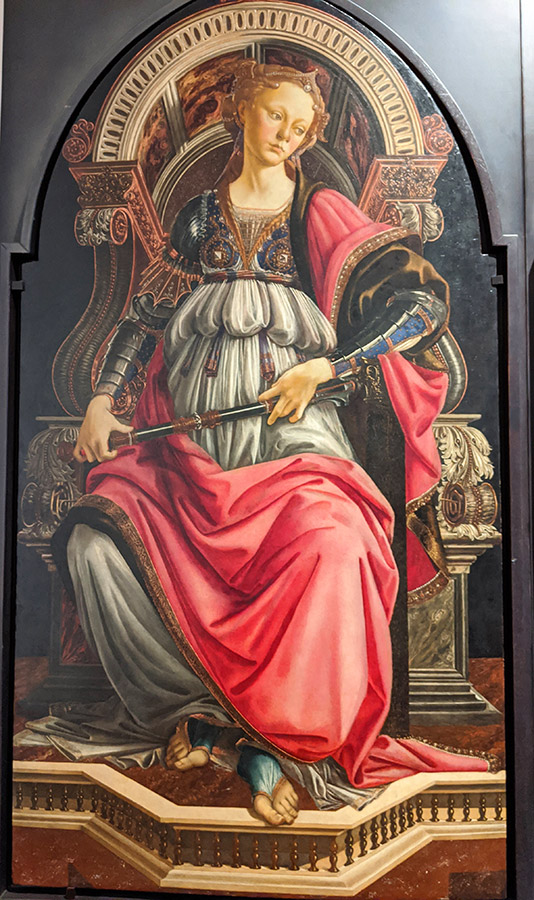
I later learned that the translucence of the colors came from painting in tempera, where the ground pigments are mixed with egg yolks rather than oils.
Michelangelo, Da Vinci and Botticelli all overlapped in Florence at the same time. This was fascinating to me. I thought about how culture reaches a point of development where advanced souls will choose to incarnate in a place like this so their gifts can be recognized, and these places shift around the globe over time. Back then they were just piling on in Florence.
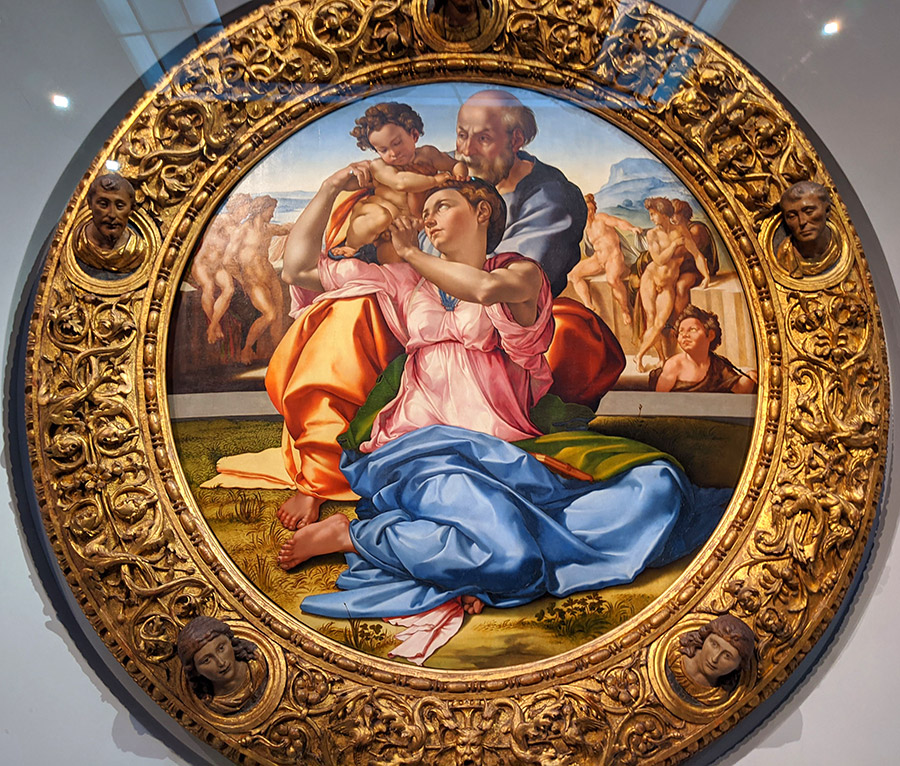
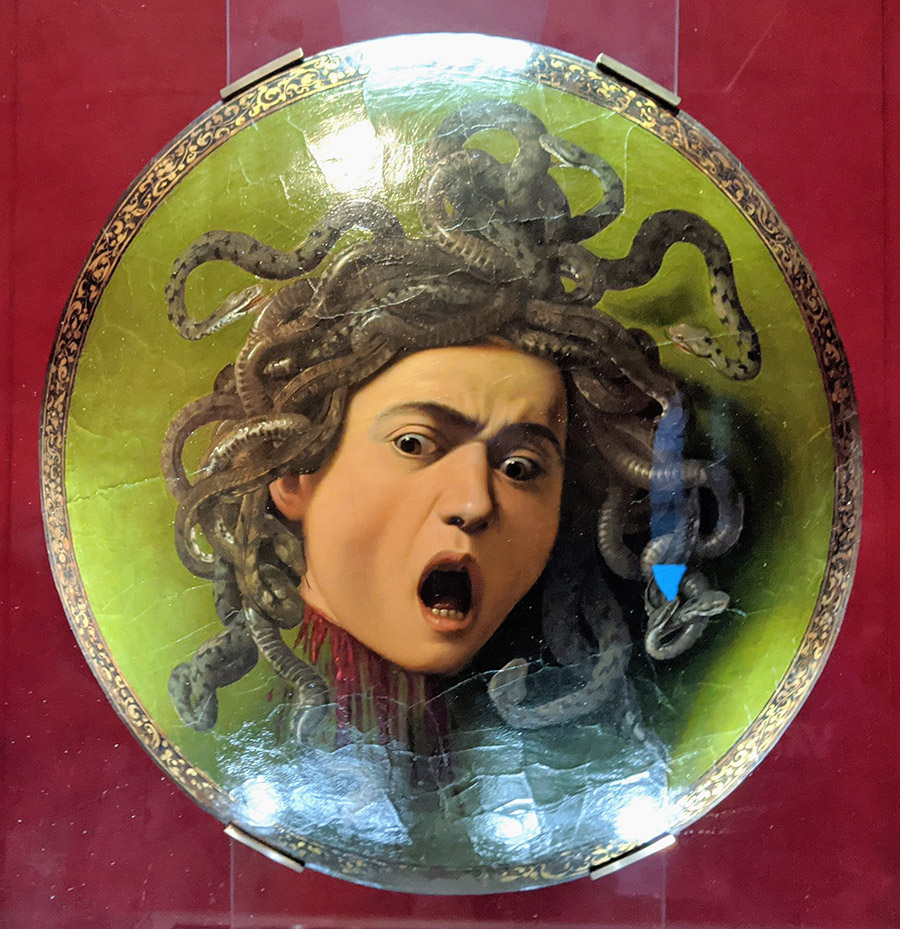
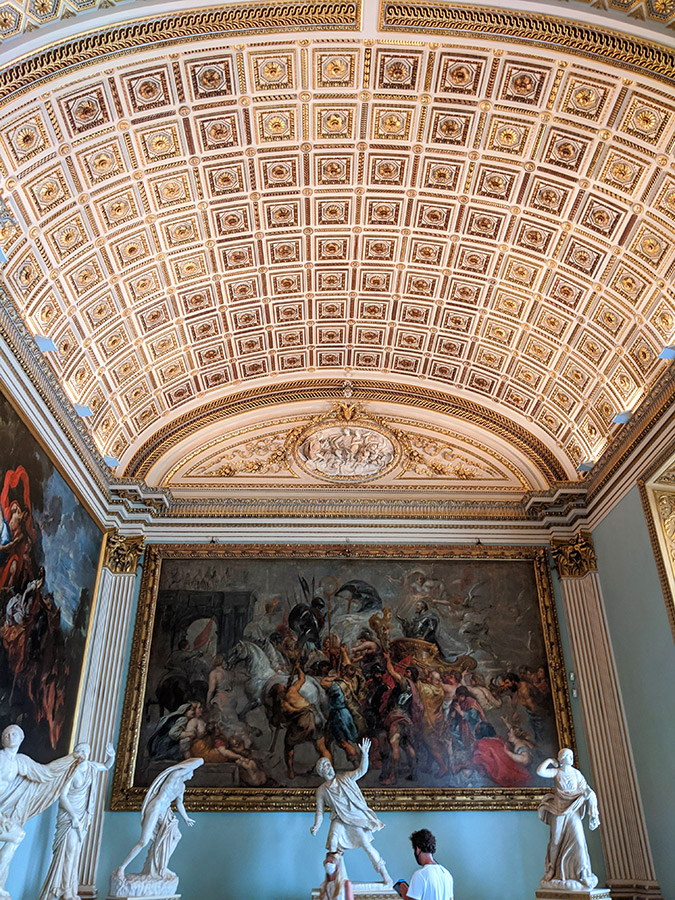
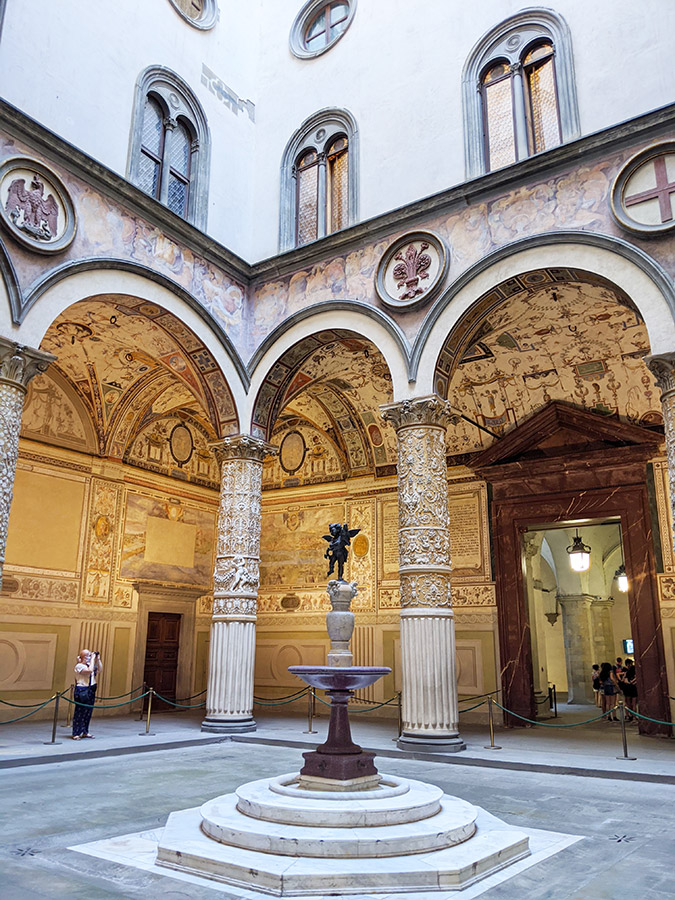
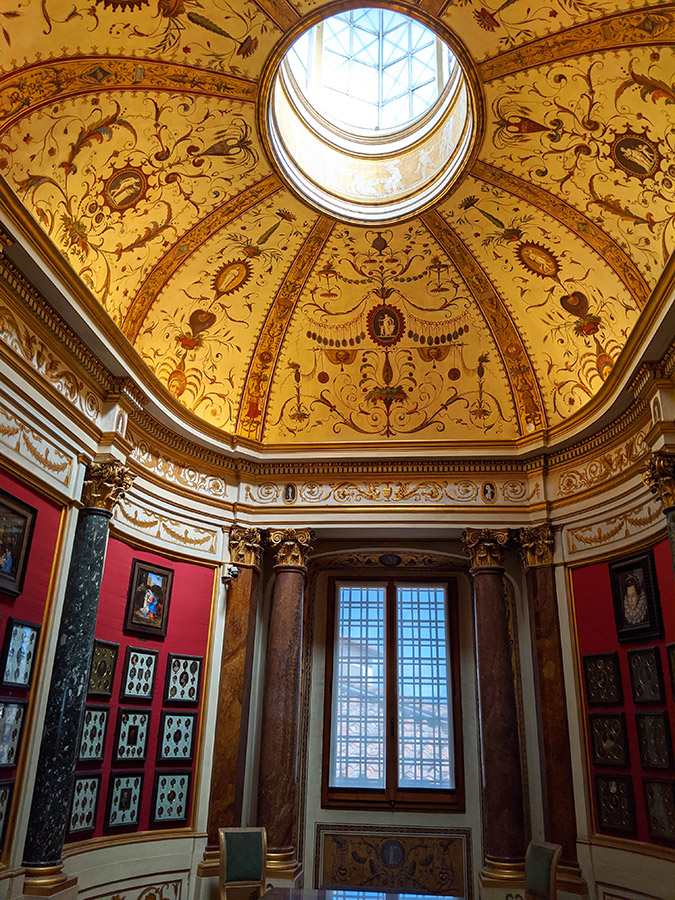
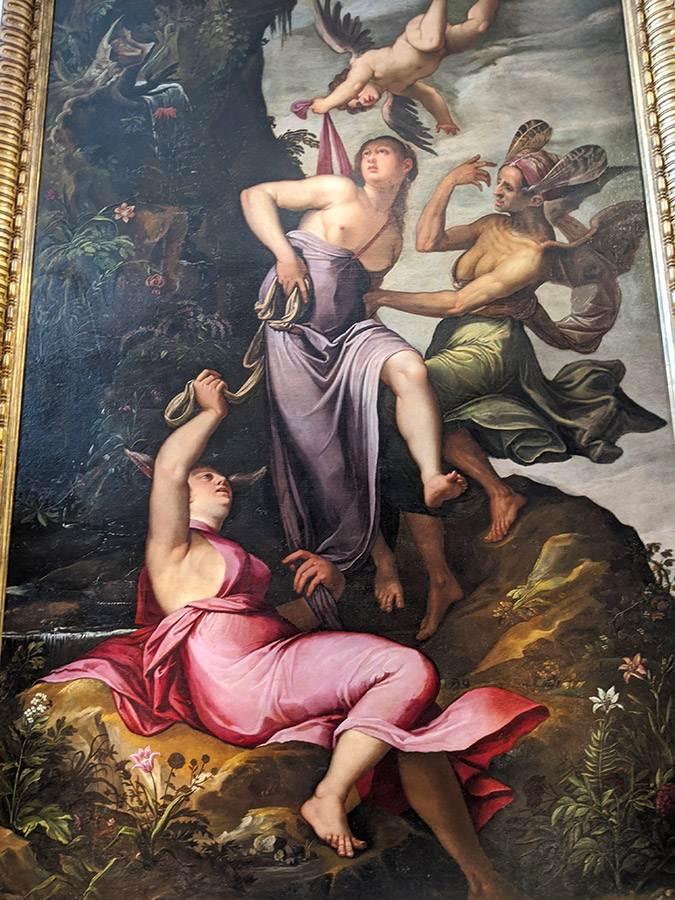
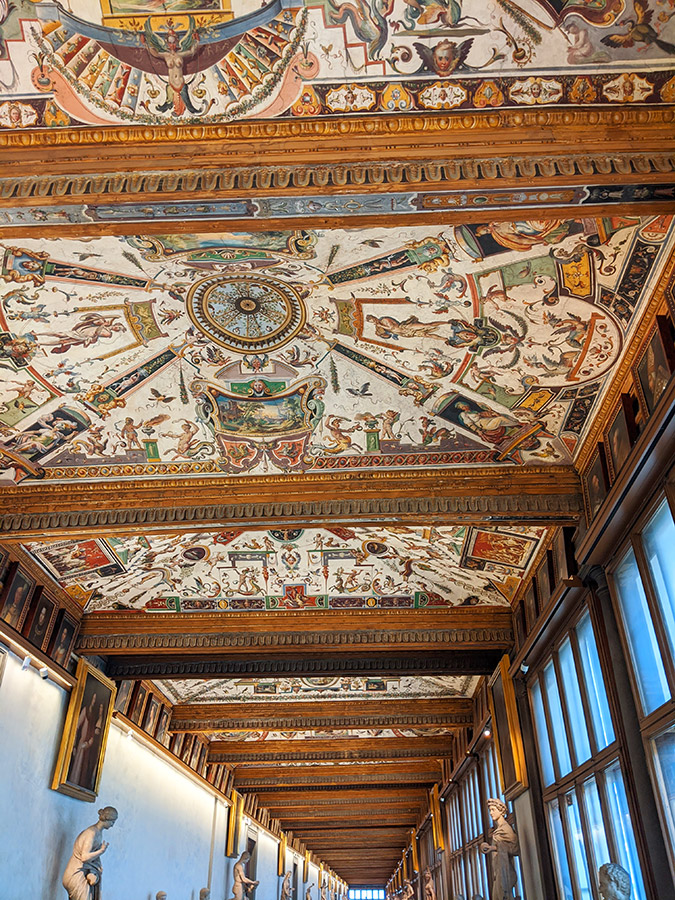
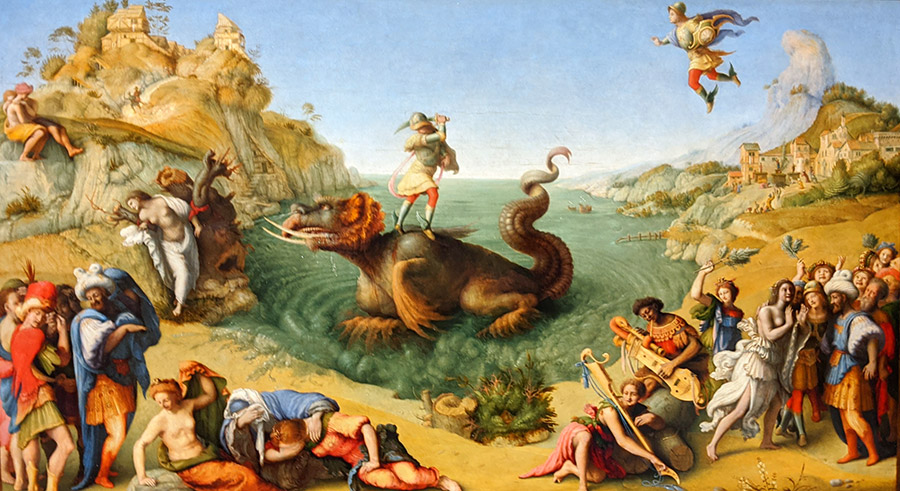
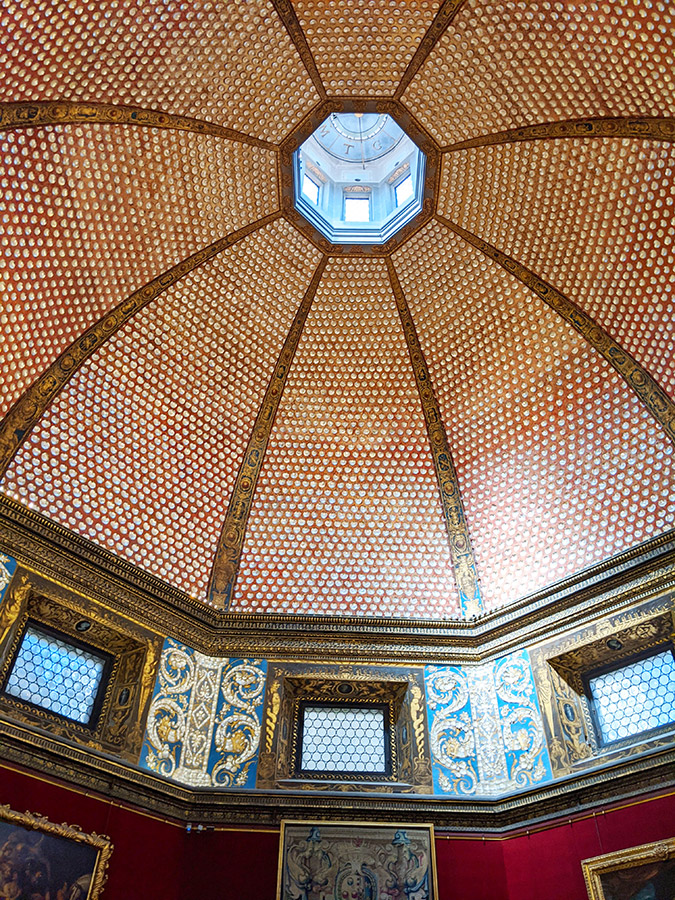
The Uffizi also had sections devoted to Greek and Roman art, in case you were jonesing to see a dude wrestle a Minotaur.
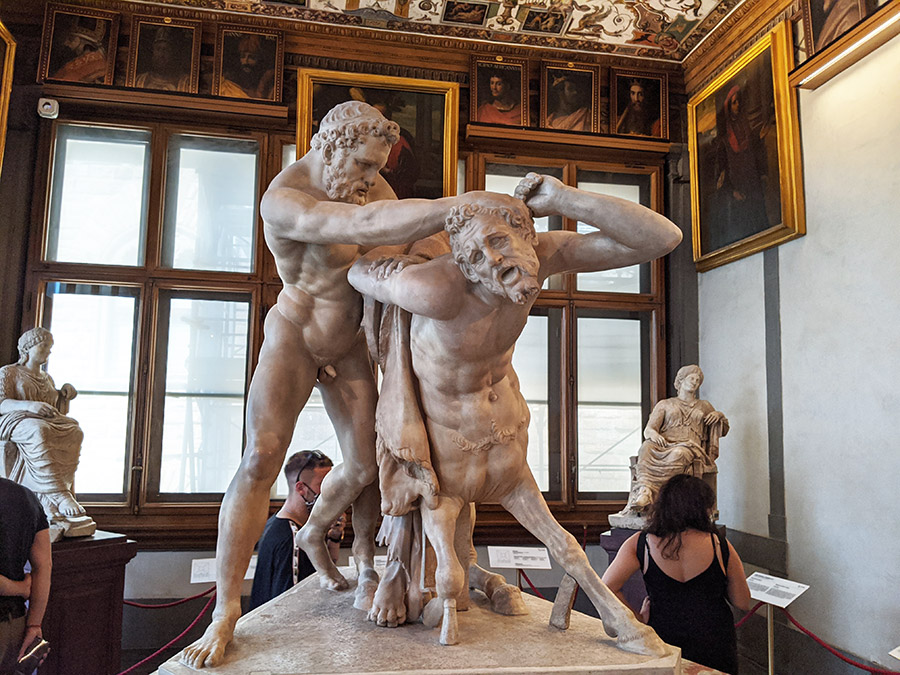
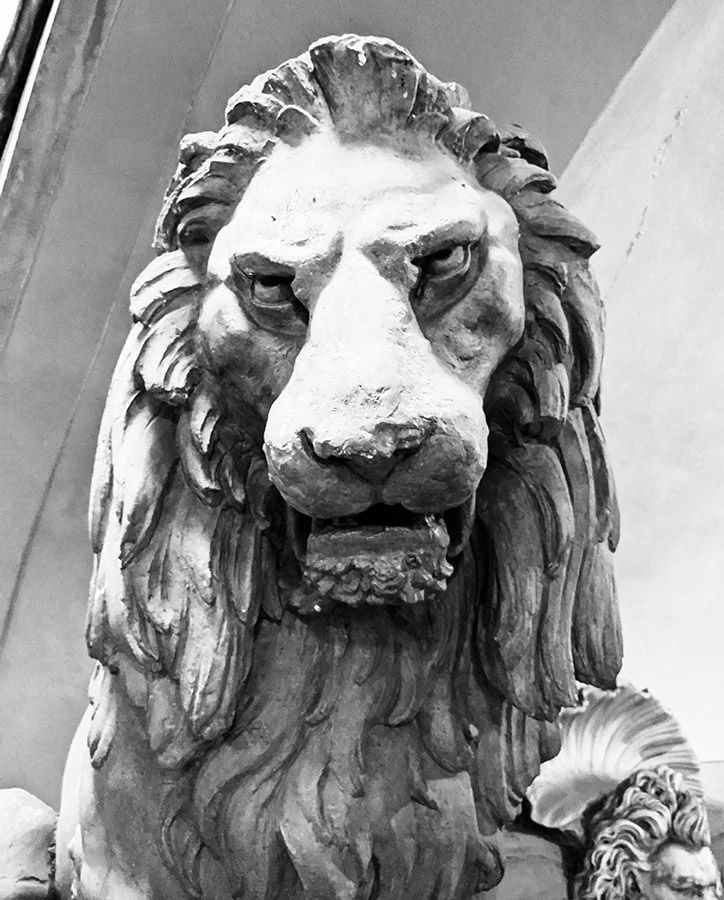
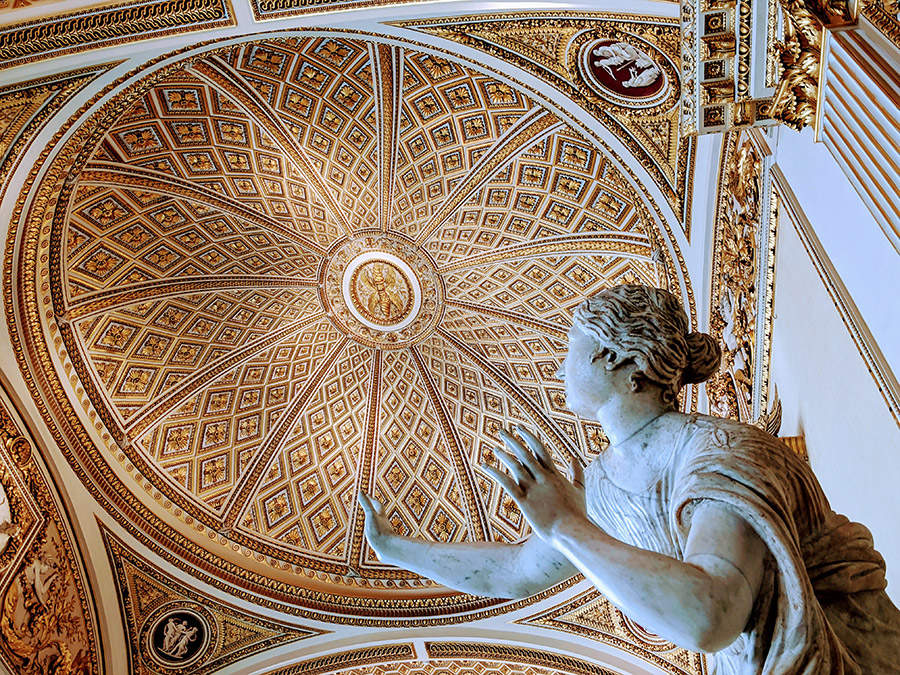
Over the course of this trip I gradually discovered that Italians are no better than the French when it comes to understanding their own language when you introduce even the slightest mispronunciation. When I was in Garda I was talking to a very helpful and friendly train station employee about where I was going and he was baffled when I said “Rimini.” It turned out that even though I was pronouncing it right phonetically, I was putting the emphasis on the wrong syllable, and this rendered him completely helpless in interpreting the sounds I had just made. Eventually it clicked for him and he said “Ohhhhh, RiMEEni!” a very slight variation on what I had been saying. He wasn’t trying to be a dick, but it was like the computer code didn’t compute when there were any variations at all.
I feel like someone visiting America could ask “How do I get to CH-EYE-CA-Goooo?” and the average American would ignore that they mispronounced every last syllable of the word and just tell them to drive toward the big lakes until they hear a hilarious accent.
Later on in Florence, I made two attempts to visit a vegan restaurant that was about a twenty minute walk across town from my guest house. The first time, I arrived to discover they were closed. I mean, the lights were on and people were eating but the girl said they were closed and wouldn’t serve me any food, in spite of their website and Facebook page both saying they were open at that time. Whatevs. The next day I tried again, walking to the restaurant in the pouring rain. The reviews I’d read said that the Eggplant Parmesan was heavenly, but pretty much everything else on the menu sucked. I ordered the Parmesana and the girl completely ignored what I said and brought me a drink instead. Hmmm.
I repeated the request. “Oh!” she said. “It’s finished.” The eggplant’s finished? What was it doing? Never mind. Dammit, they’re out of eggplant. Well, the lasagna might be-
“Also lasagna is finished.” Well shit.
I scanned the menu for a minute before deciding.
“I’ll have the tagliatelle.”
The girl looked at me like I’d just farted.
“Wut?” she asked.
Hmmm. I’d better put more of an Italian spin on this.
“Tah-lee-ah-tay-lay?”
She looked at me like a deer in headlights and I heard a faucet drip in the back of her mind.
I tried again and after a long, awkward pause she said:
“Oh! You mean taheaayeaugh!”
She’d somehow skipped the G, the L, the T and the other two Ls but I answered yes, that noise that just came out of your mouth is exactly what I meant. Of course.
This naturally is fine. You’re Italian, it’s your language, you pronounce that shit however you want, have fun. I’ve never heard the word pronounced anything like that, and I said it pretty much the way Italian people in the US do, but whatever, doesn’t matter. I'm 100% certain that I was in the wrong with my terrible Italian, no doubt, but I was just baffled that she couldn’t bridge that gap at all. You have six things on the menu and you couldn’t discern which one I meant without a pronunciation that was utterly identical to your own? Hmmm, that’s just kinda weird.
Anyway, I’m having fun complaining about this, but the deserts I ended up getting instead were completely baller so none of this mattered.

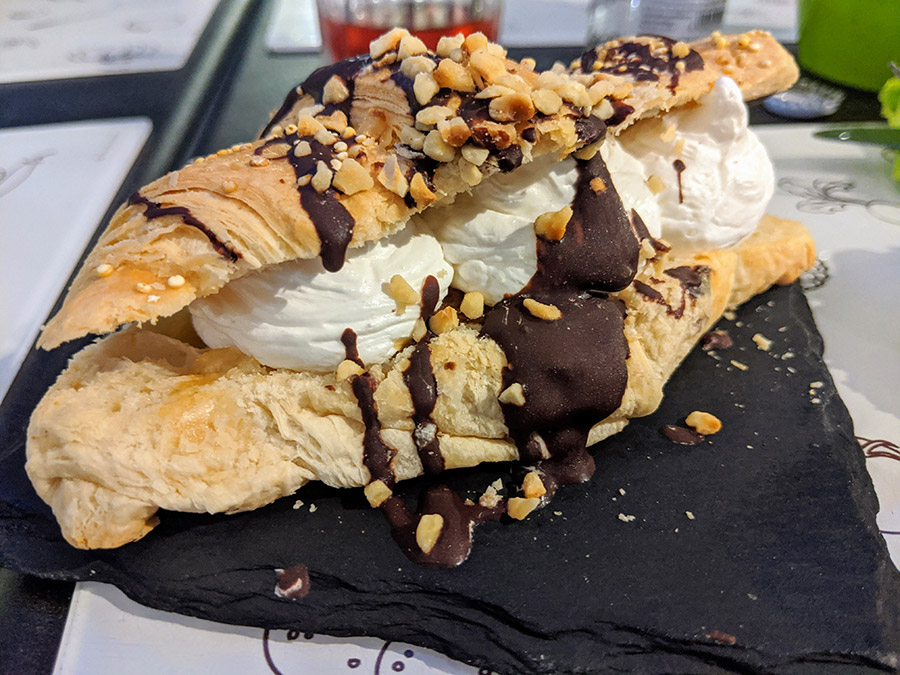
I found the language situation endlessly fascinating though. I feel like if I worked at a restaurant in the US and, say, a Chinese person came in and shouted “HAYM-BAR-GAR!” I would be able to say “Well, you may have mispronounced every syllable in that word, but this is a restaurant with a limited menu and I’m an intelligent reasoning person, so I’m pretty confident you want a hamburger and I will bring you that.” This just seems like basic problem solving and I was surprised to see seemingly reasonable Italian folks unable to do this over and over again.
I’ve had some similar experiences speaking Spanish in South America, so all together it’s made me start to wonder if people in the US are just really forgiving about mispronunciation. Maybe because we’re a nation of immigrants, and many of us interact with people frequently who are still learning our language, we’ve developed a legitimate skill for understanding imperfect English, which becomes something like second nature.
Or maybe it’s some innate distrust of authority that gives us a sense of “You go! Pronounce that shit however you want, don’t let The Man tell you how to say that word!” Who knows?
Or maybe English is just so effed up that you have to give people a pass or else nobody would understand anybody else. Maybe Canadians and Brits and Aussies and Kiwis and South Africans are all just as forgiving and laid back about it, I don’t know. But I find it all so fascinating.
I have to admit I took some small pleasure in watching French people in Italy being stonewalled or scoffed at when they mispronounced things in Italian. Sucks, doesn’t it! Maybe now you’ll- never mind, they’re already gone. Off to find a French restaurant.
The Colosseum is smaller than I expected.
I mean, it’s big for the ancient world, but you couldn’t play a soccer match in there. I don’t think. I’m not an expert on soccer. I think it would just be the goalies booting the ball back and forth to each other, which could get boring after a while.
I’d secured special tickets that let me wander around on the floor of the Colosseum, where the gladiators had fought. This was cool as shit.
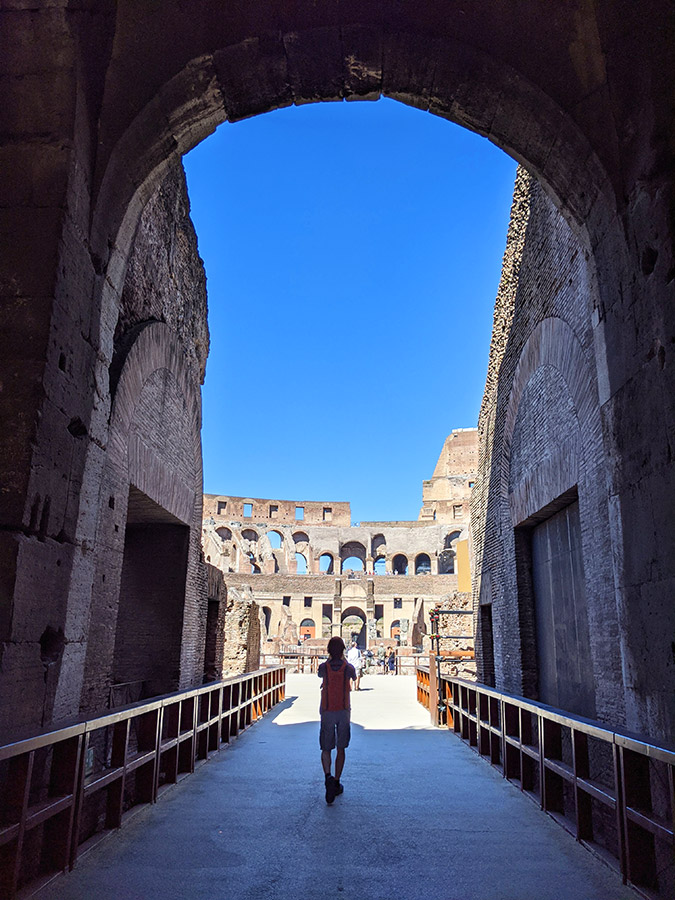
Standing on the floor of the arena, I imagined looking up at the bloodthirsty, roaring crowd in the stands, and then across the floor at a lion or some big motherfucker running at me with a trident and a net. Jesus man, what am I, a giant fish? Who did I piss off at Long John Silver’s this time?
The first thing you notice, surprisingly, is that the floor of the arena isn’t solid. I’d always assumed it was just, you know, the ground. But it turns out it was a wooden platform covered in sand. Beneath that lies the hypogeum, the “underground”.
Originally this was just a pit that was filled with water, so the Romans could relive famous naval battles by sailing ships around inside the Colosseum. I guess they either used small ships or there wasn’t a whole lot of navigating going on. After a time the water was drained and the Romans built a complex maze of masonry and machines underneath the arena floor for hoisting up lions and shit. This underground was like the backstage area for the entertainments that were being put on in the Colosseum, filled with ramps, pulleys and trap doors that allowed trees and pissed off ostriches to suddenly pop out of the arena floor, to the delight of the crowd.
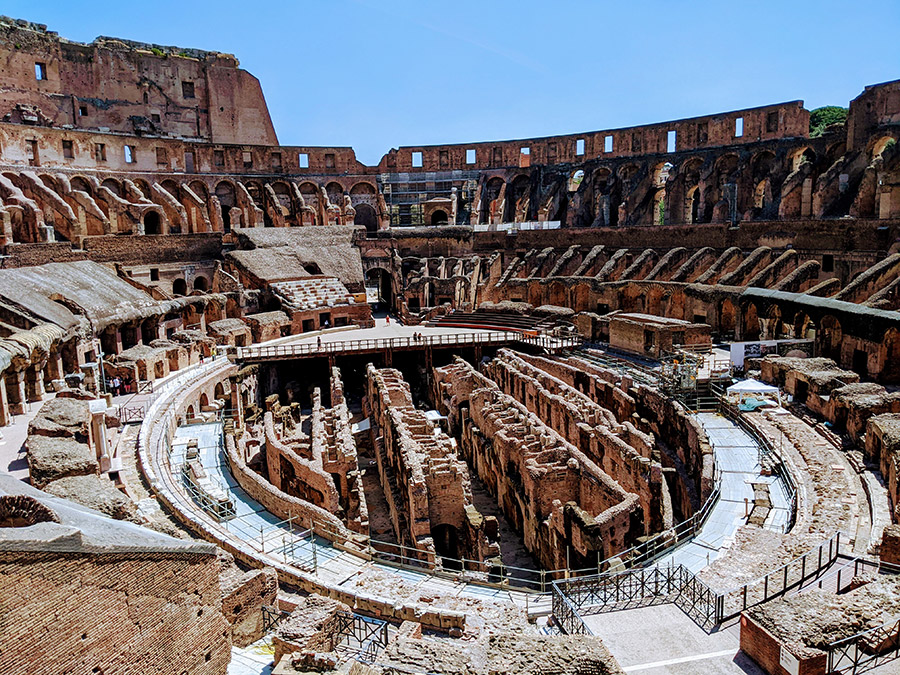
The Romans would stage faux hunts, decorating the arena floor with trees and exotic plants and setting loose a wild animal to be killed. They brought in thousands of animals from Africa and the Middle East, and the arena floor saw lions, giraffes, elephants, bears, hippopotami, crocodiles, rhinos, panthers and bison. The animals were also used to execute prisoners, where the condemned was sent naked into the arena to be eaten alive. This seems excessive to me, at least give the dude some pants you monsters. I wonder if they always used lions for this or if you got the luck of the draw on what animal would be waiting in the arena when you marched out in your birthday suit. I’d be pretty excited if I got giraffes. Those guys are chill.
When the people got bored of this they would put on shows retelling mythological dramas, sometimes with a condemned prisoner playing the hero so he could be killed in whatever gruesome way the story dictated, burned alive or kicked in the nuts by a centaur or whatever.
Walking around the higher floors, I realized most of the upper levels were missing. The Colosseum was originally larger than this, and once held 80K people. Not bad.
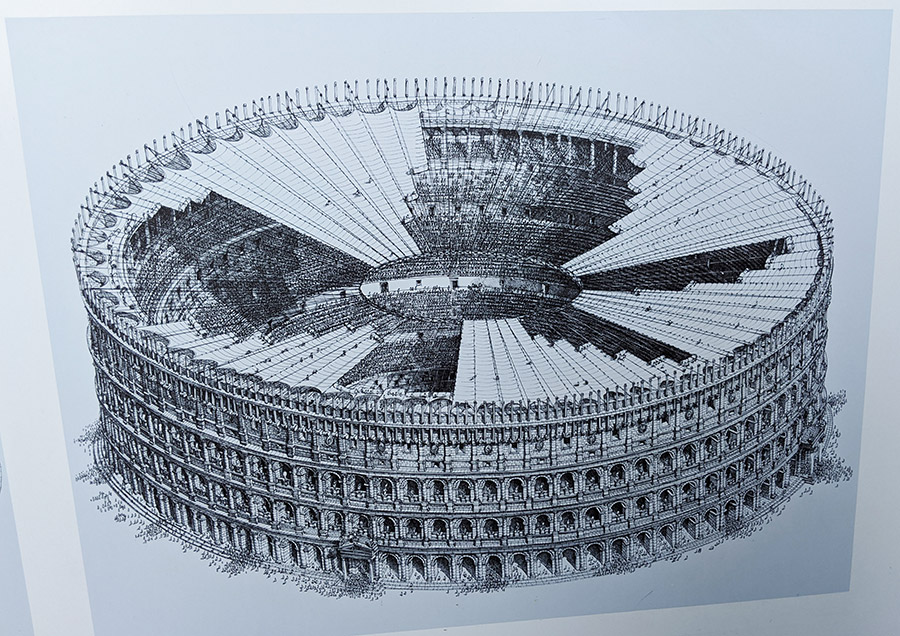
Then it caught on fire. More than once. Then there were earthquakes, which I didn’t know Italy had. Then over time the games fell out of favor after Rome stopped procuring the best gladiators, and the Colosseum fell into disuse.
By the 6th century a small chapel was built inside the Colosseum, as Christianity took over the region and the arena became a pilgrimage site, in honor of all the Christian martyrs who had been sentenced to death in the Colosseum for failing to worship the Roman gods. A later pope advised his followers to collect sand from the arena floor as a holy relic, as it was soaked in the blood of martyrs.
The powerful Frangipani family took over the Colosseum around 1200 and fortified it into their own private castle.
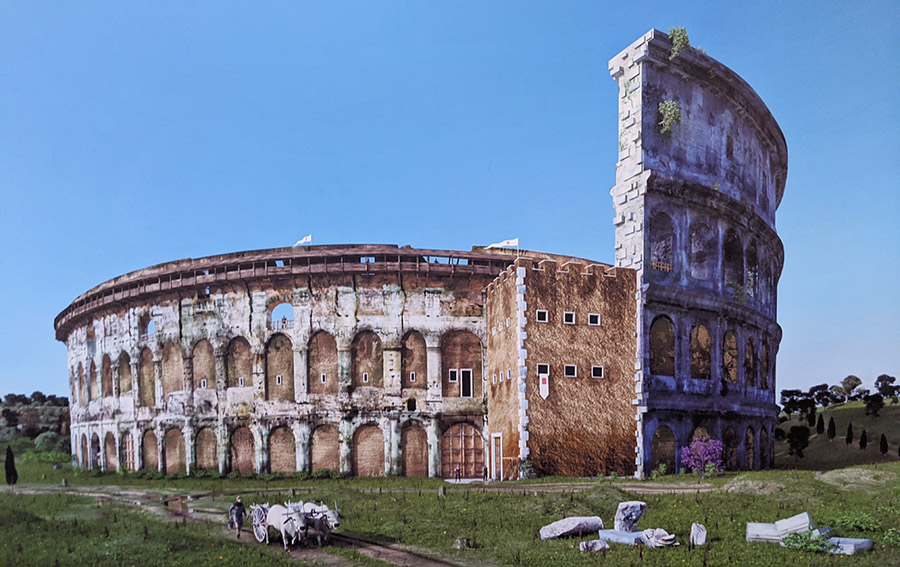
After the south side of the Colosseum collapsed in the earthquake of 1349, the building was stripped for building stone and quicklime, becoming known as something of quarry to the locals.
This was the part I found the most fascinating about the Colosseum. It has existed for nearly two thousand years, but for most of its history it wasn’t THE COLOSSEUM. It was a forgotten relic of a fallen empire. Local farmers moved in, and the rooms that had once hosted rich Romans now housed cows and other livestock.
Over time the Colosseum became completely overgrown with hundreds of species of plant life, some of them quite exotic and from far-off destinations, thought to have been accidentally imported as seeds in the stomachs of the wild animals the Romans brought from far and wide to die in the Colosseum.
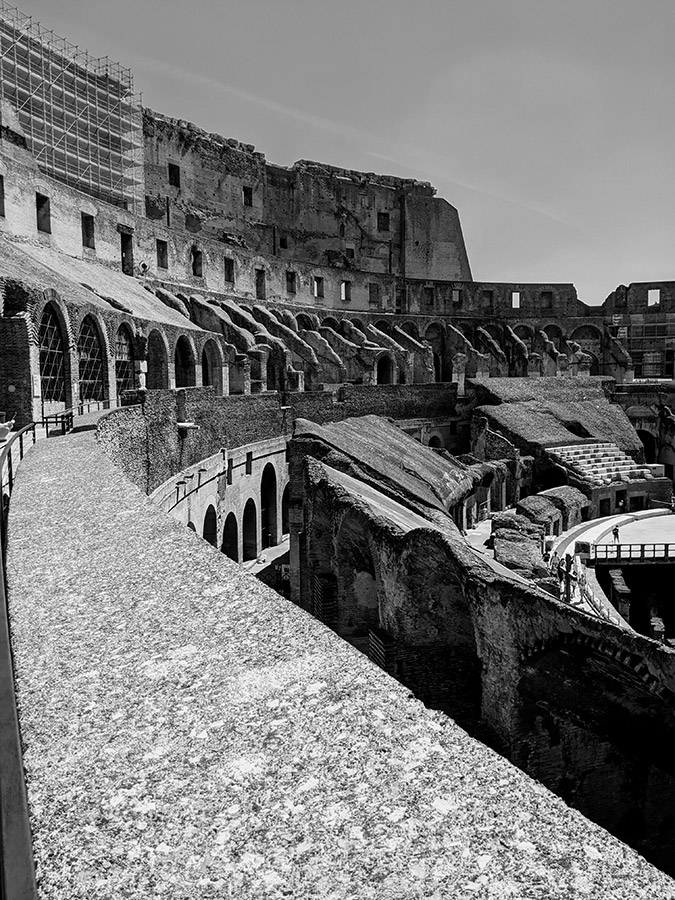
The tidbit that fascinated me the most was the history of Necromancy within the Colosseum ruins. An estimated 400,000 people died in this one relatively small physical space during its history. Because of this it became known as a Doorway to Hell in local lore, and ghost stories proliferated. Witches and sorcerers would make potions from the plants growing within the Colosseum. And Necromancers, including the poet Virgil, would visit the arena in an attempt to communicate with the dead.
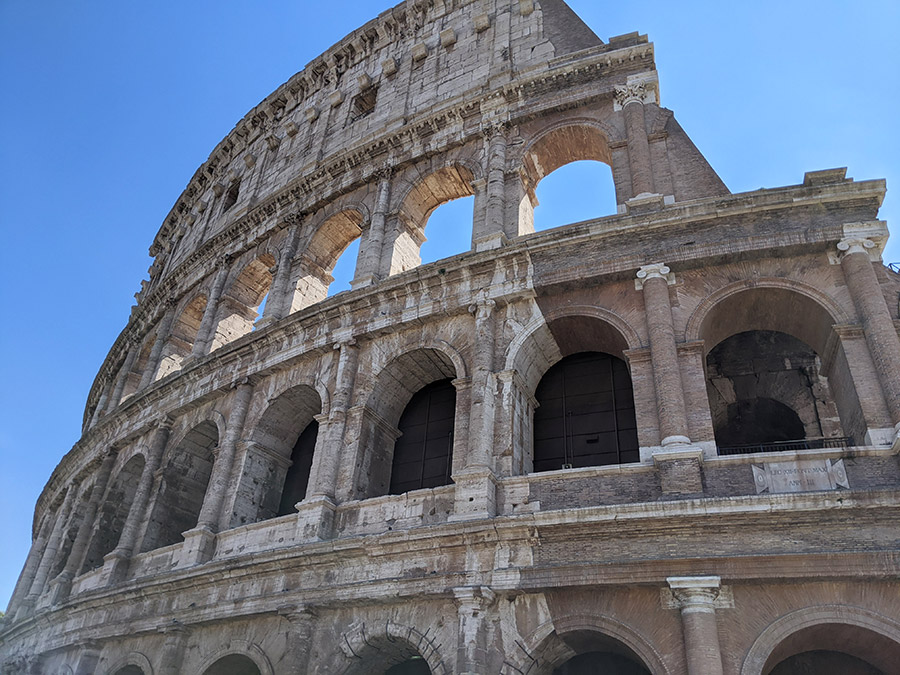
Walking down the street outside the Colosseum, a guy in a full Roman Legionnaire’s costume looked me up and down and told me my socks were too long.
I think, I mean. My Italian is as they say nosogooood.
Weird.
Near the Colosseum you have the famous Roman Forum. This sucks hard and you should avoid it.
The website said “Coming to Rome without seeing the Roman Forum would be like going to Paris and not seeing the Eiffel Tower!”
Sure, if the Eiffel Tower fell down, and then the locals sold all the metal for scrap, and all that was left was a few bolts and a slight impression in the ground, then yes, seeing the Eiffel Tower would be just like this. After taking forever to find which of the surrounding streets actually held the Forum entrance, I wandered around in the hot sun and looked at a bunch of nothing.
You’ve got to have something for me to see here, Rome. If I’m going to be looking at a pile of rocks there’s got to have been something REALLY interesting going on here. Jesus won a breakdancing contest in this spot? Okay! “This was an important square and stuff until it wasn’t.” Meh.
This is when I discovered that the ruins in Rome are RUINED, man. They’ve had a rough time. You’ve got to use your imagination.
There was a nice set of columns and an arch. So there’s that.
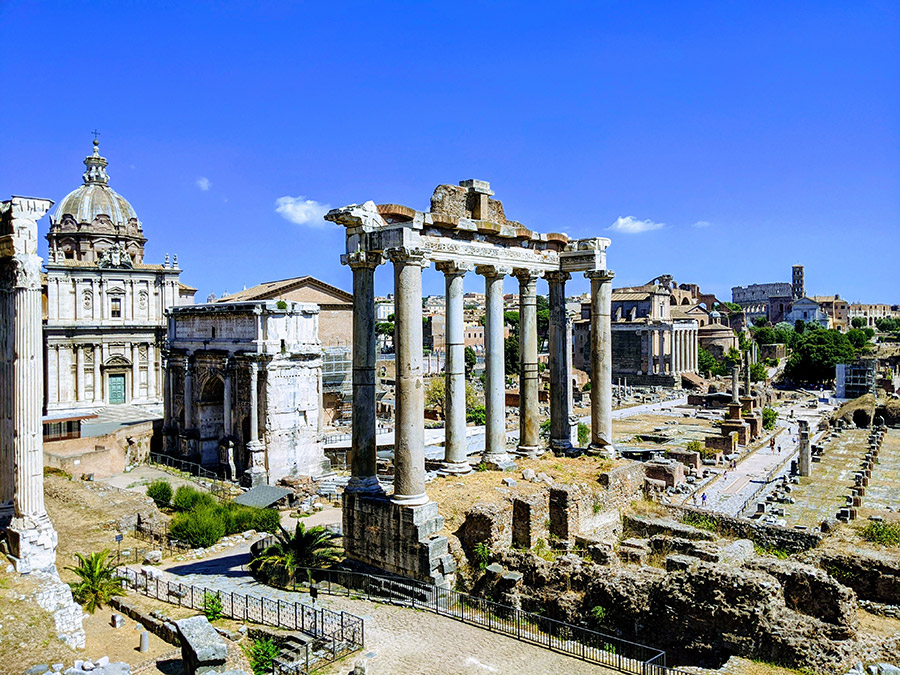
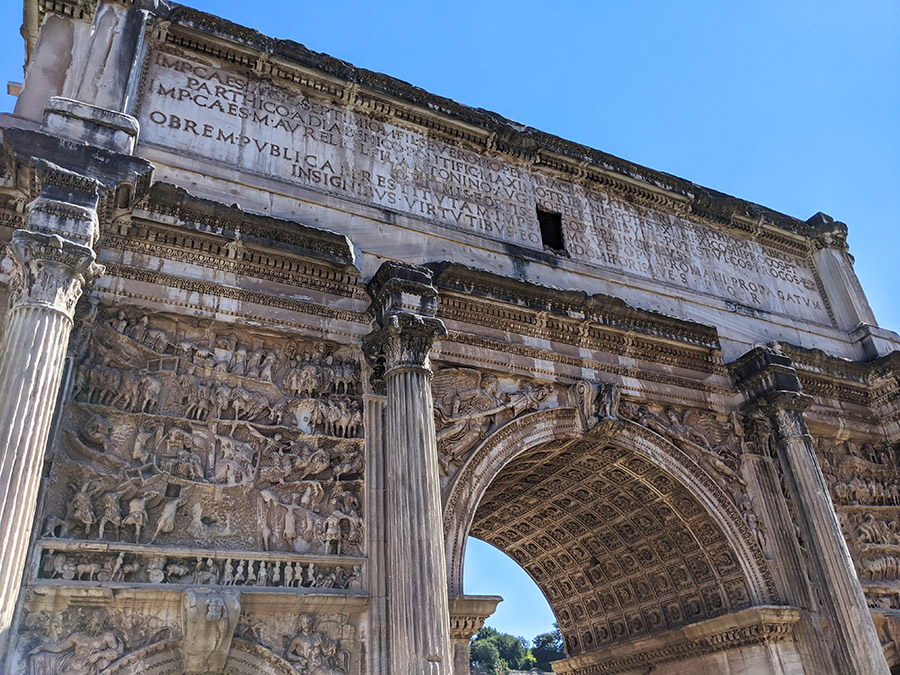
The rest was more akin to a garbage-strewn field behind a Wendy’s. At least I passed some nice things while I was wandering around the area trying to find the entrance.
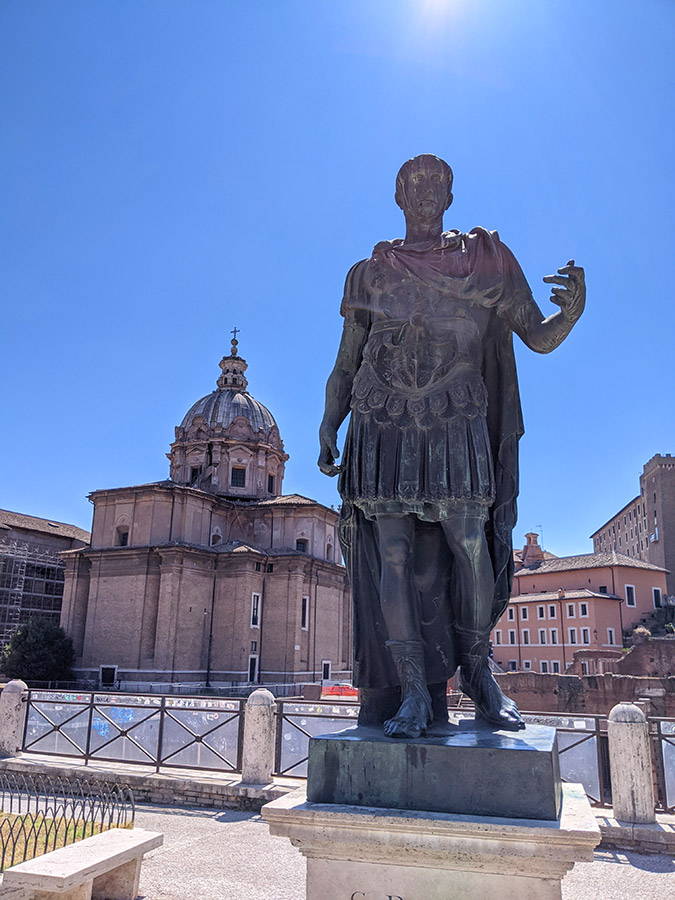
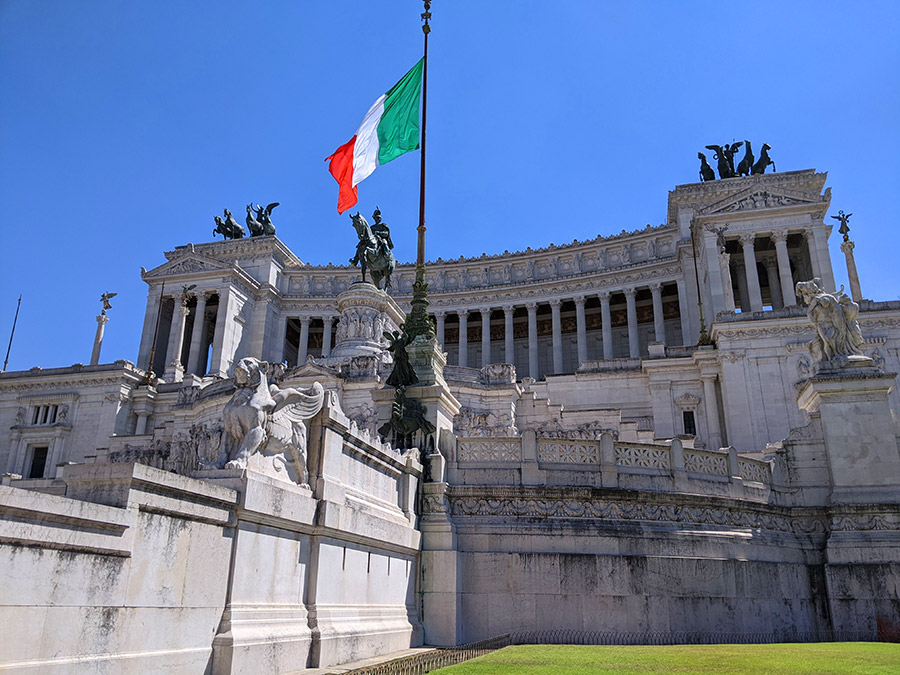
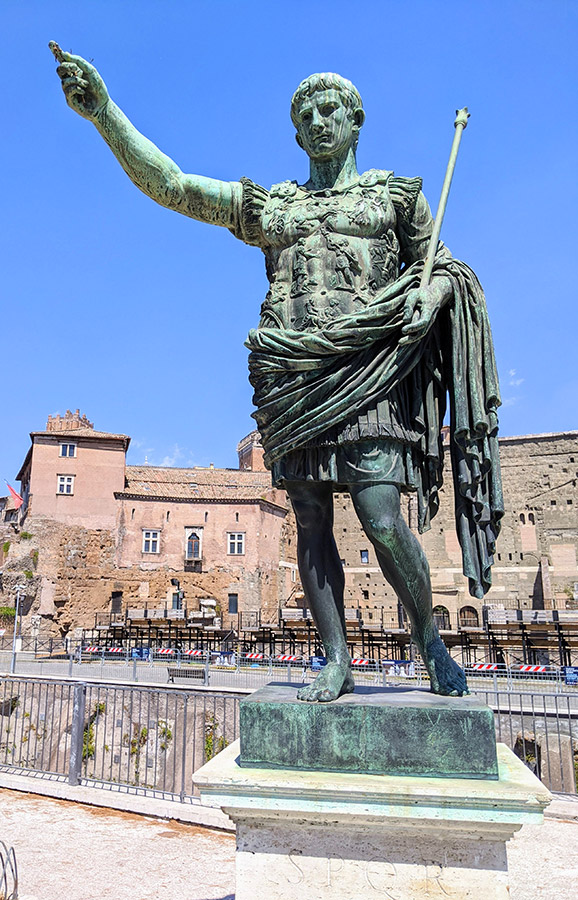
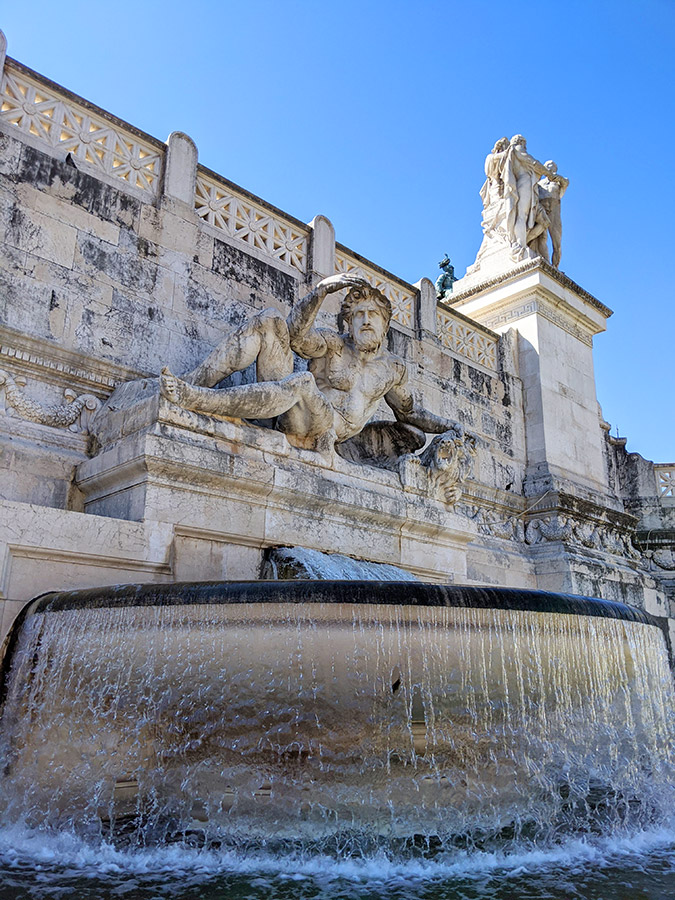
Not far from the Forum was Palatine Hill, the central of the seven famous hills that Rome was founded upon. This is a very important area that is the very birthplace of Rome and there is absolutely nothing to see here. Snoozer.
Likewise, if you’re headed to Rome, be sure not to carve out time to see the Villa Borghese gardens, especially if you were considering walking all the way across Rome and up a steep hill with no sidewalk to see them. There’s not much there, so much so that after I’d taken a photo of the cute fact that the gardens themselves are shaped like a heart, I didn’t see anything I wanted to take a picture of the whole time I was actually there.
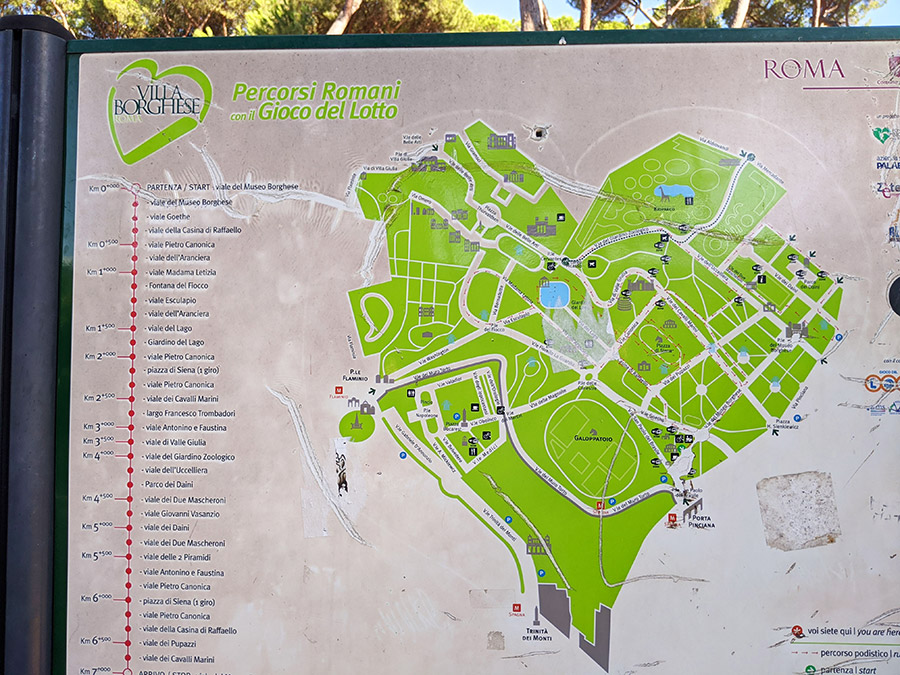
I was staying in a swank guesthouse in a chic shopping district. I’m certain I was the only person staying there because the guy at the front desk went home as soon as I checked in. This kind of thing happened a few times on this trip and I was never sure if people were happy a tourist had finally come or annoyed that they had to come to work just for this hoser.
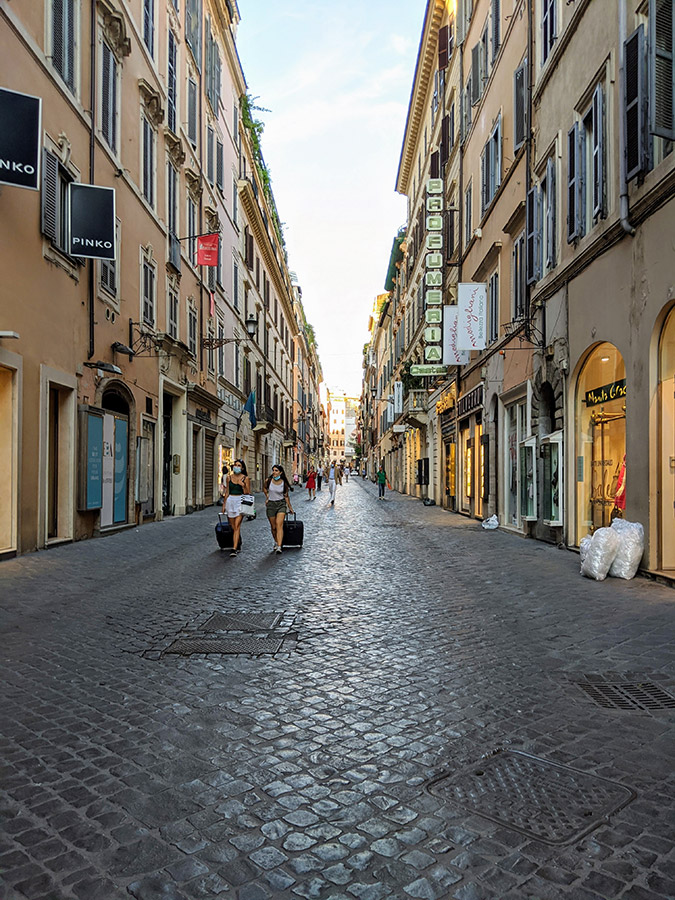

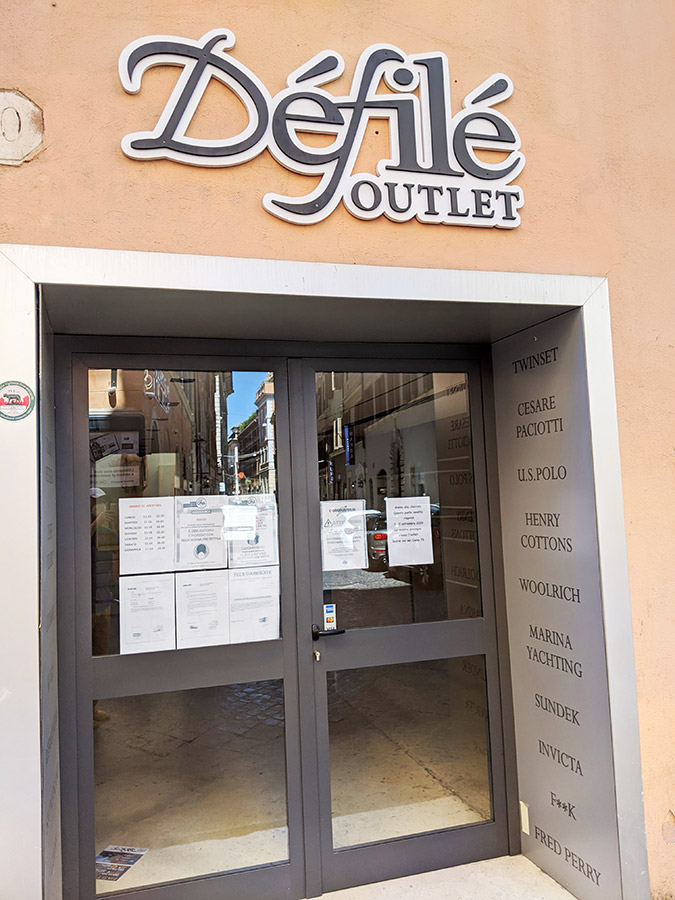
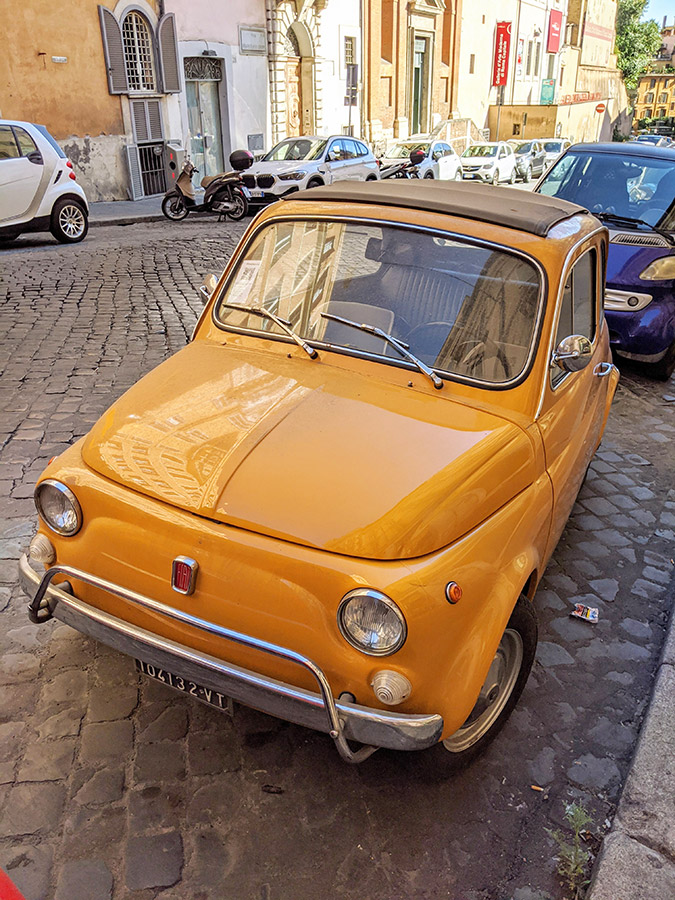
On my way to see The Pantheon I found a vegan ice cream shop, which you may detect as a theme in my attempt to beat the summer heat. I snapped a picture fast as the grandiose cone began to instantly melt down my hand.
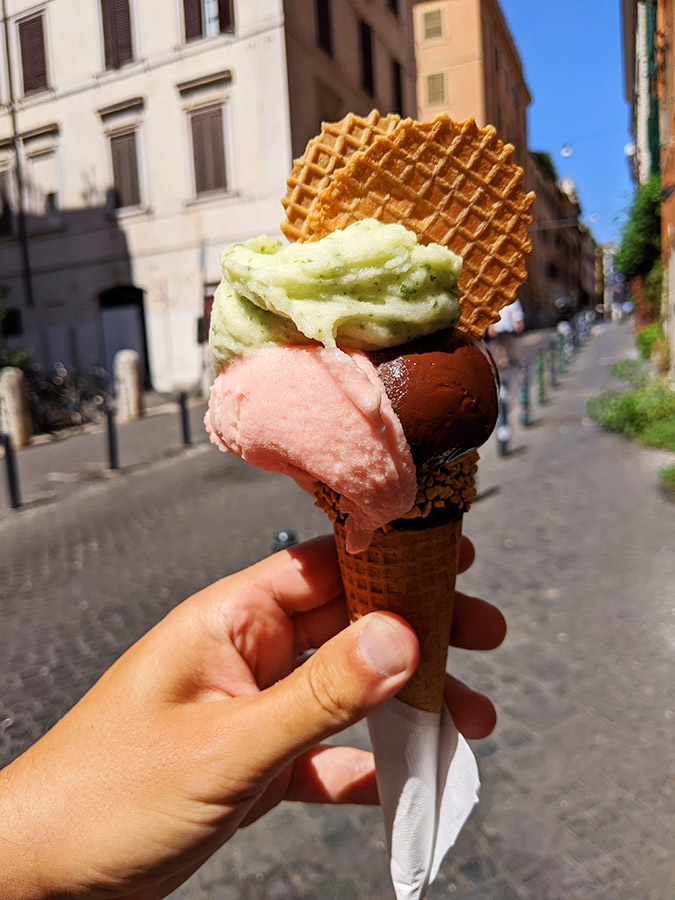
The Pantheon was, indeed, neat to see.
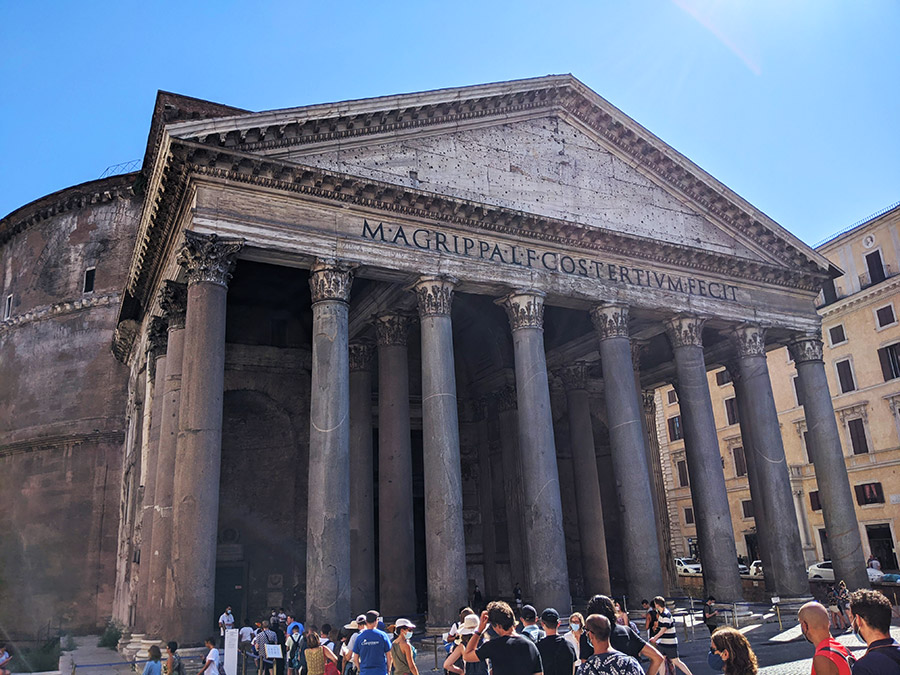
This is a circular Roman Temple from 126 AD that is probably the best-preserved building remaining from ancient Rome. The inside is beautifully restored and an interesting variety of people are buried here, from the painter Raphael to Italian kings.
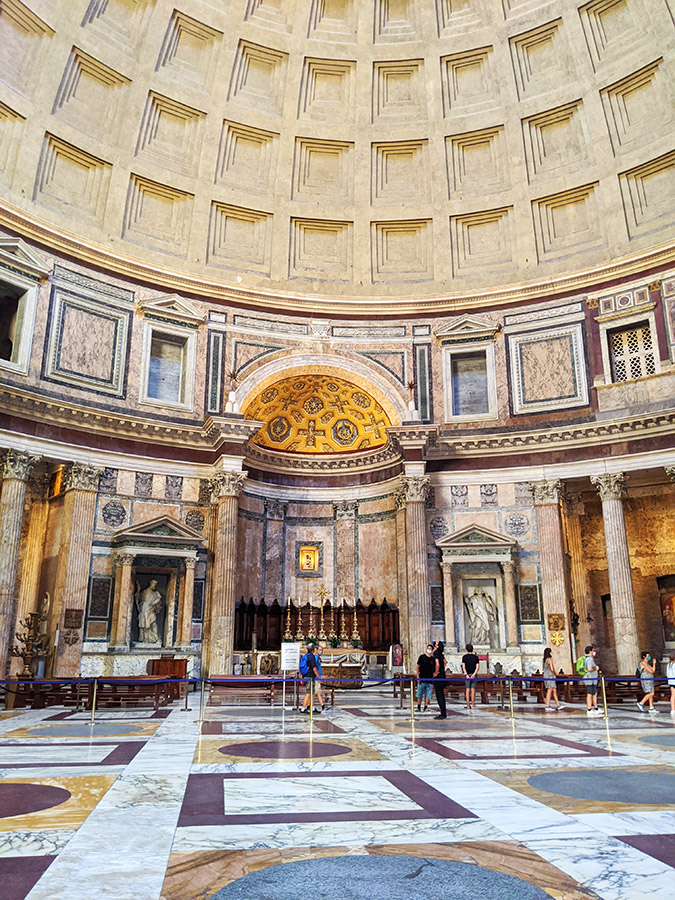
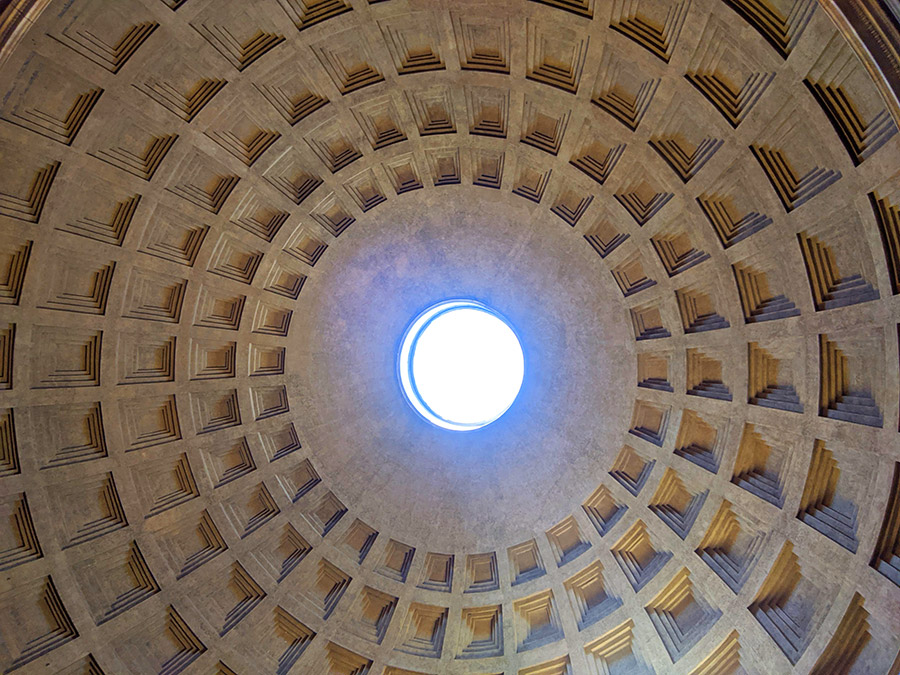
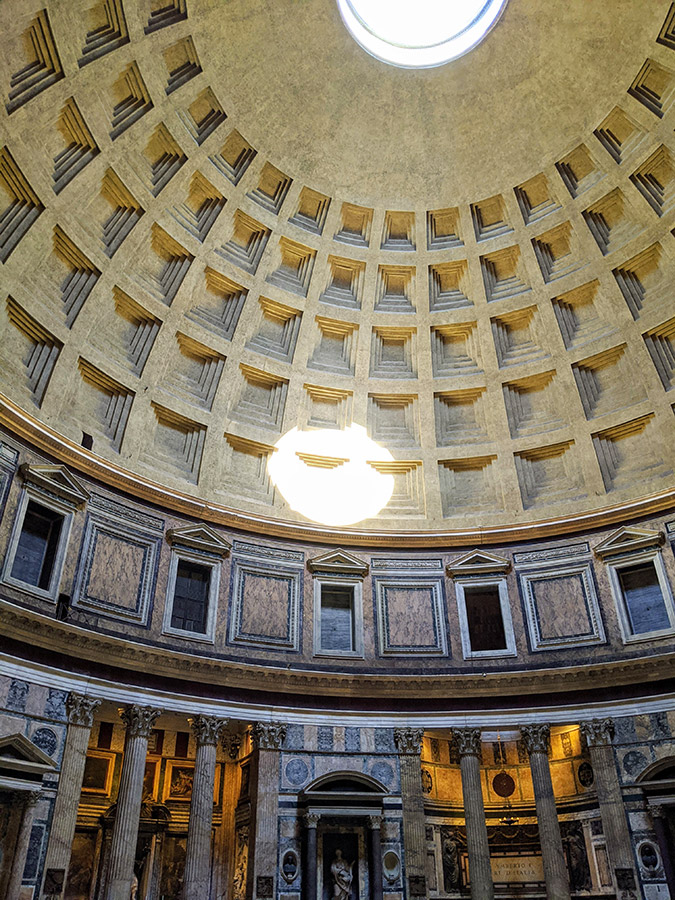
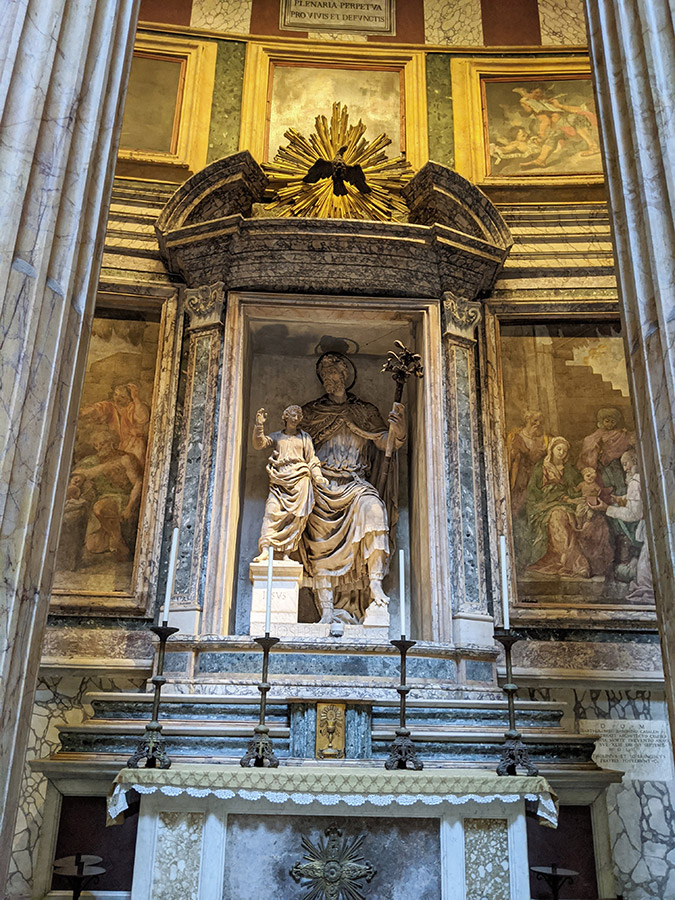
No trip to Rome would be complete without seeing the Trevi Fountain, the fountain you want to see if you find yourself in Rome and you’re dead-set on seeing a fountain.
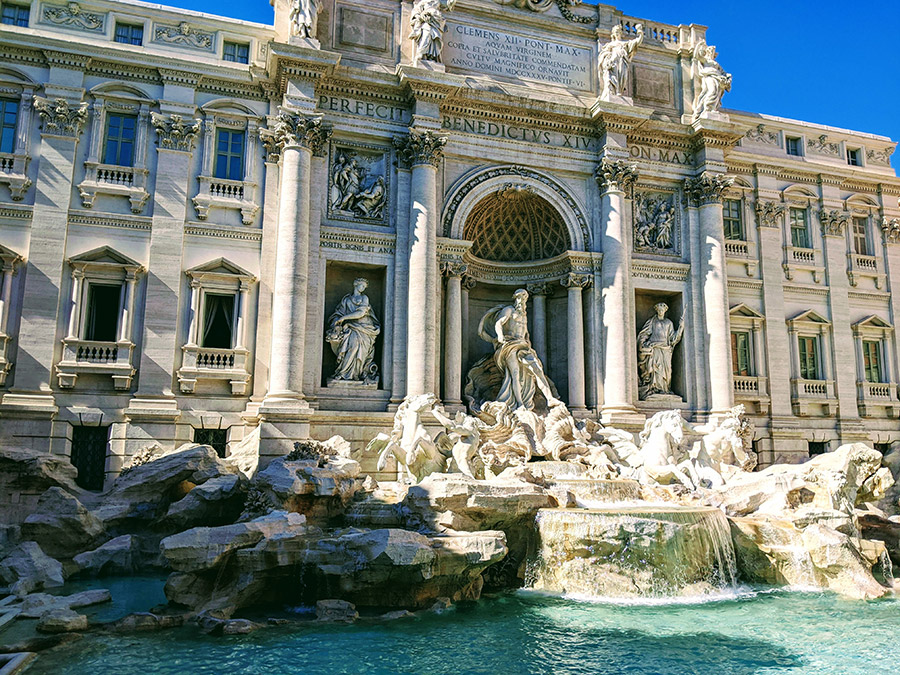
The sculptures that make up the fountain depict Oceanus leading a bunch of hippocamps, winged horses with the lower body of a fish, which seems like it would be really inconvenient. The parts of the human brain that deal with memory, the hippocampus, are sort of named after these mythological creatures, due to those brain structures being shaped like a seahorse.
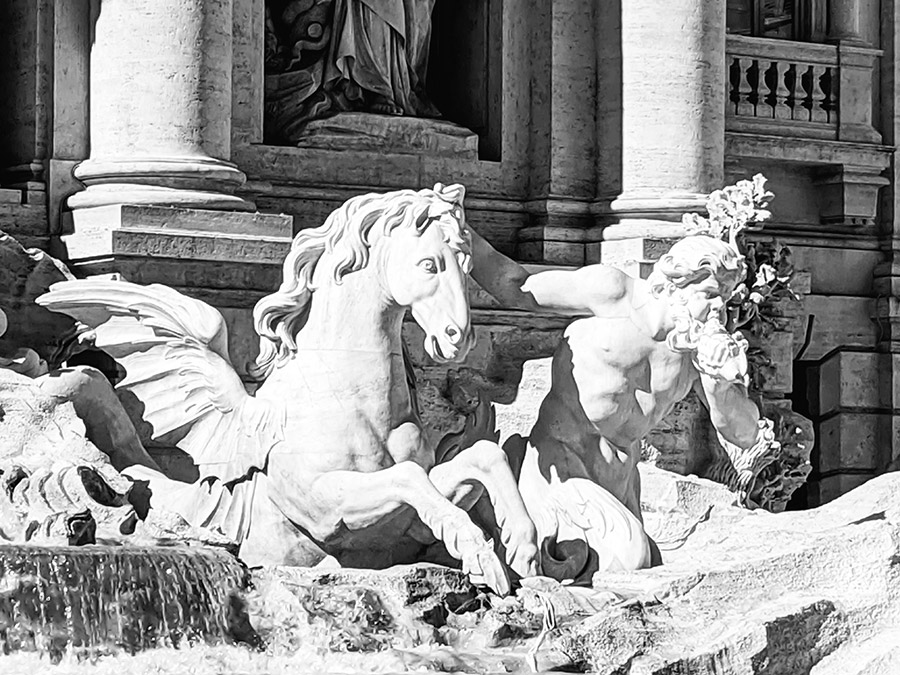
Local tradition holds that if you throw a coin with your right hand over your left shoulder into the fountain, you will return to Rome one day. Toss two coins and you will return to fall in love. Three coins buys you a return to Rome, love and marriage. This was the plot of the 1950s movie Three Coins in a Fountain, and the Frank Sinatra title song, which I only know because of Steve Martin singing it on the bus in Planes, Trains and Automobiles. Every day roughly 3,000 euro coins are thrown into the fountain, totaling around a million and a half euros per year. Which seems like it would buy a lot of return tickets to Rome, if not true love.
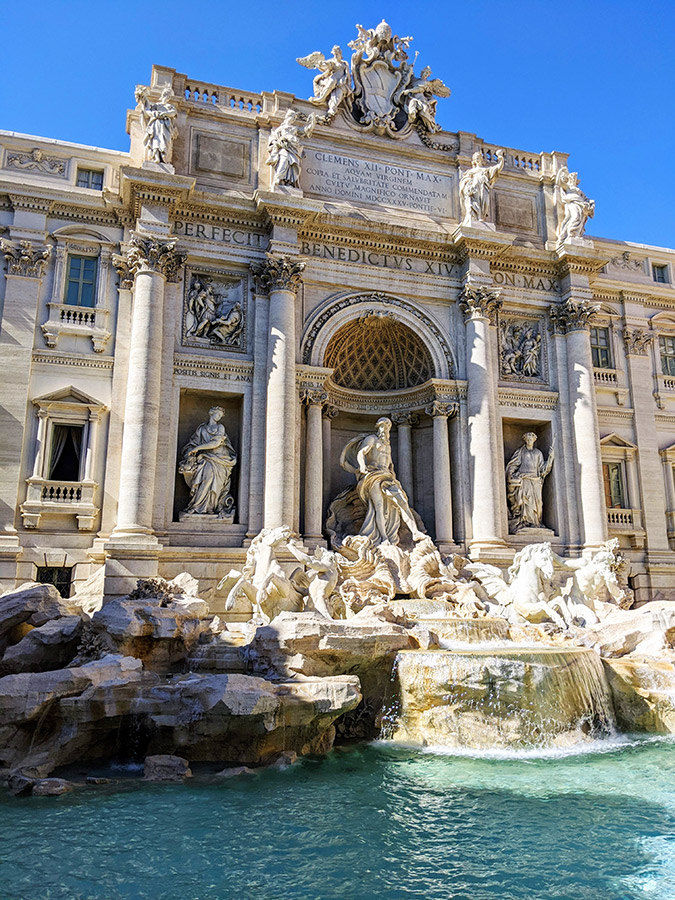
If you toss four coins, the fountain plays a message about requiring exact change.
Across town you can find the Spanish Steps.
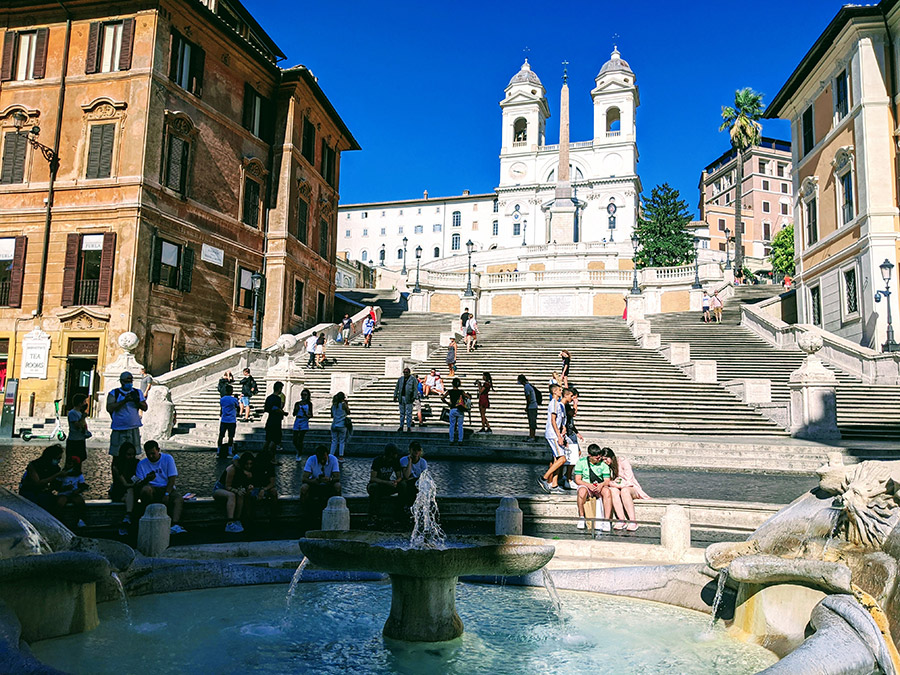
Yep, them steps sure are Spanish, I tell you what. It’s against the law to eat while sitting on the steps, which just seemed cruel because I had just found a whole box of vegan ice cream cones in a grocery store down the street, it was 95 degrees and I didn’t have access to a refrigerator.

Guess I’m gonna just walk down the street stuffing ice cream cones into my face until I fall down. When in Rome!